As filed with the Securities and Exchange Commission on December 10, 2004
UNITED STATES
SECURITIES AND EXCHANGE COMMISSION
Washington, D.C. 20549
SCHEDULE 14A
(RULE 14a-101)
INFORMATION REQUIRED IN PROXY STATEMENT
SCHEDULE 14A INFORMATION
Proxy Statement Pursuant to Section 14(a) of the
Securities Exchange Act of 1934
Filed by the Registrantx
Filed by a Party other than the Registranto
Check the appropriate box:
o Preliminary Proxy Statement
o Confidential, for Use of the Commission Only (as permitted by Rule 14a-6(e)(2))
o Definitive Proxy Statement
o Definitive Additional Materials
x Soliciting Material Pursuant to § 240.14a-12
PROVINCE HEALTHCARE COMPANY
(Name of Registrant as Specified in Its Charter)
(Name of Person(s) Filing Proxy Statement, if Other Than the Registrant)
Payment of Filing Fee (Check the appropriate box):
| | | | | | | |
| | | x | | No fee required. |
| | o | | Fee computed on table below per Exchange Act Rules 14a-6(i)(1) and 0-11. |
| | | | | | | |
| | | (1 | ) | | Title of each class of securities to which transaction applies:
|
| | | (2 | ) | | Aggregate number of securities to which transaction applies:
|
| | | (3 | ) | | Per unit price or other underlying value of transaction computed pursuant to Exchange Act Rule 0-11 (set forth the amount on which the filing fee is calculated and state how it was determined):
|
| | | (4 | ) | | Proposed maximum aggregate value of transaction:
|
| | | (5 | ) | | Total fee paid:
|
| | | | | | | |
| | o | | Fee paid previously with preliminary materials. |
| | o | | Check box if any part of the fee is offset as provided by Exchange Act Rule 0-11(a)(2) and identify the filing for which the offsetting fee was paid previously. Identify the previous filing by registration statement number, or the form or schedule and the date of its filing.
|
| | | (1 | ) | | Amount previously paid:
|
| | | (2 | ) | | Form, Schedule or Registration Statement No.:
|
| | | (3 | ) | | Filing Party:
|
| | | (4 | ) | | Date Filed:
|
This filing relates to a planned combination of Province Healthcare Company (“Province Healthcare”) and LifePoint Hospitals, Inc. (“LifePoint Hospitals”) pursuant to the terms of an Agreement and Plan of Merger, dated as of August 15, 2004 (the “Merger Agreement”) by and among LifePoint Hospitals, Lakers Holding Corp., Lakers Acquisitions Corp., Pacers Acquisition Corp. and Province Healthcare.
| | | The following materials are attached hereto: |
| | | Materials used by Michael J. Culotta, the Chief Financial Officer of LifePoint Hospitals, in a presentation made at the CIBC World Markets 15th Annual Healthcare Conference on November 10, 2004. |
| |
| | | Transcript of a conference call held on October 28, 2004 relating to Province Healthcare’s financial results for the third quarter and nine months ended September 30, 2004. |
| |
| | | Transcript of a conference call held on October 27, 2004 relating to LifePoint Hospitals’ financial results for the third quarter and nine months ended September 30, 2004. |
******
In connection with the proposed transaction, LifePoint Hospitals and Province Healthcare have filed with the Securities and Exchange Commission (“SEC”) a joint proxy statement/prospectus, as part of a Registration Statement on Form S-4, and other relevant materials. The definitive joint proxy statement/prospectus will be mailed to the stockholders of LifePoint Hospitals and Province Healthcare as promptly as possible. Investors and security holders are advised to read the joint proxy statement/prospectus and other relevant materials when they become available, as well as any amendments or supplements to those documents, because they will contain important information about LifePoint Hospitals, Province Healthcare and the proposed transaction. In addition, the joint proxy statement/prospectus and other relevant materials filed by LifePoint Hospitals or Province Healthcare with the SEC may be obtained free of charge at the SEC’s web site at www.sec.gov. In addition, investors and security holders may obtain free copies of the documents filed with the SEC by LifePoint Hospitals by contacting Investor Relations, LifePoint Hospitals, Inc., 103 Powell Court, Suite 200, Brentwood, Tennessee, 37027, Phone: (615) 372-8500 and by Province Healthcare by contacting Investor Relations, Province Healthcare Company, 105 Westwood Place, Suite 400, Brentwood, Tennessee, 37027, Phone: (615) 370-1377.
LifePoint Hospitals and Province Healthcare, and their respective directors and executive officers, may be deemed to be participants in the solicitation of proxies from their respective stockholders with respect to the transactions contemplated by the Merger Agreement. Information about the directors and executive officers of LifePoint Hospitals, and their interests in the transactions contemplated by the Merger Agreement, including their ownership of LifePoint Hospitals common stock, is set forth in the proxy statement for LifePoint Hospitals’ 2004 annual meeting, which was filed with the SEC on April 28, 2004. Information about the directors and executive officers of Province Healthcare, and their interests in the transactions contemplated by the Merger Agreement, including their ownership of Province Healthcare common stock, is set forth in the proxy statement for Province Healthcare’s 2004 annual meeting, which was filed with the SEC on April 20, 2004. Investors and security holders may obtain additional information regarding the interests of such potential participants by reading the joint proxy statement/prospectus and the other relevant documents filed with the SEC when they become available.
This document may contain statements that constitute forward-looking statements within the meaning of the Private Securities Litigation Reform Act of 1995. All statements other than statements of historical fact are statements that could be deemed forward-looking statements. Such forward-looking statements, particularly those statements regarding the effects of the merger, reflect LifePoint Hospitals, Inc.’s and Province Healthcare Company’s current expectations and beliefs, are not guarantees of performance of LifePoint Hospitals or the newly formed combined entity and are subject to a number of risks, uncertainties, assumptions and other factors that could cause actual results to differ materially from those described in the
- 2 -
forward-looking statements. For example, such risks, uncertainties, assumptions and other factors include, without limitation, the possibility that (1) the companies may be unable to obtain the required stockholder or regulatory approvals; (2) problems may arise in successfully integrating the businesses of the two companies; (3) the acquisition may involve unexpected costs; (4) the combined company may be unable to achieve cost-cutting synergies; (5) the businesses may suffer as a result of uncertainty surrounding the acquisition; and (6) the combined company may be subject to future regulatory or legislative actions. For a further discussion of these and other risks, uncertainties, assumptions and other factors, see the joint proxy statement/prospectus and LifePoint Hospitals’ and Province Healthcare’s filings with the Securities and Exchange Commission. LifePoint Hospitals and Province Healthcare undertake no duty to update forward-looking statements.
- 3 -
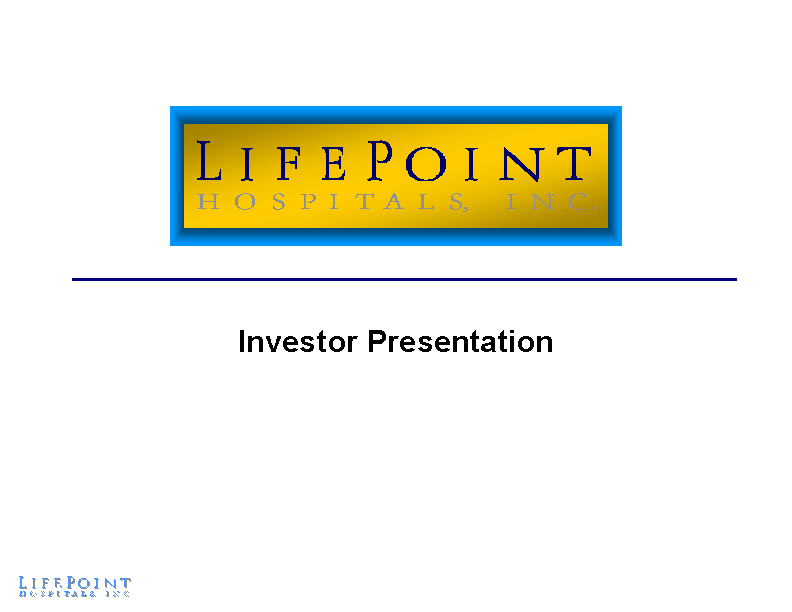
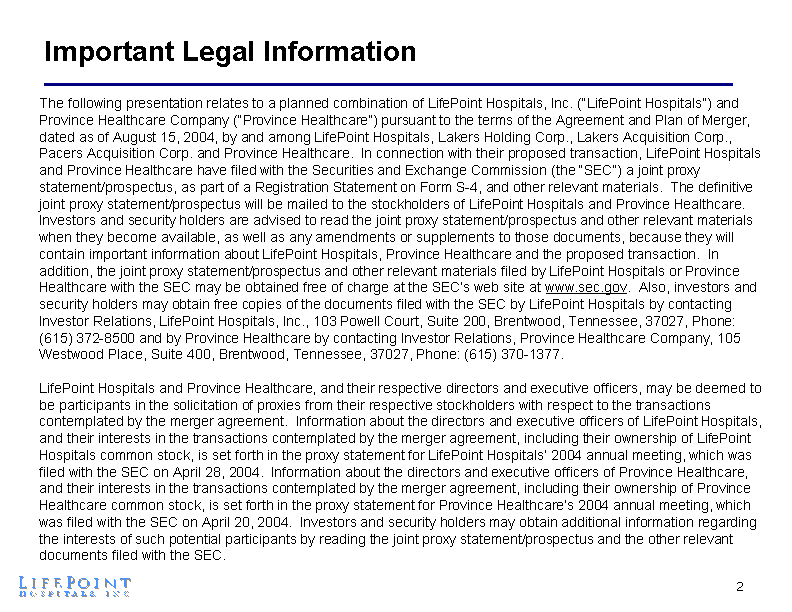
| Important Legal Information The following presentation relates to a planned combination of LifePoint Hospitals, Inc. ("LifePoint Hospitals") and Province Healthcare Company ("Province Healthcare") pursuant to the terms of the Agreement and Plan of Merger, dated as of August 15, 2004, by and among LifePoint Hospitals, Lakers Holding Corp., Lakers Acquisition Corp., Pacers Acquisition Corp. and Province Healthcare. In connection with their proposed transaction, LifePoint Hospitals and Province Healthcare have filed with the Securities and Exchange Commission (the "SEC") a joint proxy statement/prospectus, as part of a Registration Statement on Form S-4, and other relevant materials. The definitive joint proxy statement/prospectus will be mailed to the stockholders of LifePoint Hospitals and Province Healthcare. Investors and security holders are advised to read the joint proxy statement/prospectus and other relevant materials when they become available, as well as any amendments or supplements to those documents, because they will contain important information about LifePoint Hospitals, Province Healthcare and the proposed transaction. In addition, the joint proxy statement/prospectus and other relevant materials filed by LifePoint Hospitals or Province Healthcare with the SEC may be obtained free of charge at the SEC's web site at www.sec.gov. Also, investors and security holders may obtain free copies of the documents filed with the SEC by LifePoint Hospitals by contacting Investor Relations, LifePoint Hospitals, Inc., 103 Powell Court, Suite 200, Brentwood, Tennessee, 37027, Phone: (615) 372-8500 and by Province Healthcare by contacting Investor Relations, Province Healthcare Company, 105 Westwood Place, Suite 400, Brentwood, Tennessee, 37027, Phone: (615) 370-1377. LifePoint Hospitals and Province Healthcare, and their respective directors and executive officers, may be deemed to be participants in the solicitation of proxies from their respective stockholders with respect to the transactions contemplated by the merger agreement. Information about the directors and executive officers of LifePoint Hospitals, and their interests in the transactions contemplated by the merger agreement, including their ownership of LifePoint Hospitals common stock, is set forth in the proxy statement for LifePoint Hospitals' 2004 annual meeting, which was filed with the SEC on April 28, 2004. Information about the directors and executive officers of Province Healthcare, and their interests in the transactions contemplated by the merger agreement, including their ownership of Province Healthcare common stock, is set forth in the proxy statement for Province Healthcare's 2004 annual meeting, which was filed with the SEC on April 20, 2004. Investors and security holders may obtain additional information regarding the interests of such potential participants by reading the joint proxy statement/prospectus and the other relevant documents filed with the SEC. |
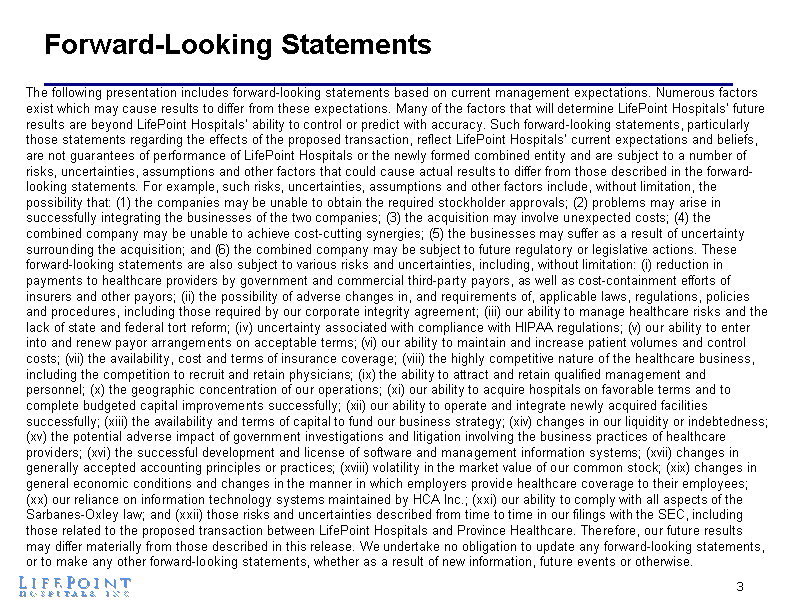
| Forward-Looking Statements The following presentation includes forward-looking statements based on current management expectations. Numerous factors exist which may cause results to differ from these expectations. Many of the factors that will determine LifePoint Hospitals' future results are beyond LifePoint Hospitals' ability to control or predict with accuracy. Such forward-looking statements, particularly those statements regarding the effects of the proposed transaction, reflect LifePoint Hospitals' current expectations and beliefs, are not guarantees of performance of LifePoint Hospitals or the newly formed combined entity and are subject to a number of risks, uncertainties, assumptions and other factors that could cause actual results to differ from those described in the forward- looking statements. For example, such risks, uncertainties, assumptions and other factors include, without limitation, the possibility that: (1) the companies may be unable to obtain the required stockholder approvals; (2) problems may arise in successfully integrating the businesses of the two companies; (3) the acquisition may involve unexpected costs; (4) the combined company may be unable to achieve cost-cutting synergies; (5) the businesses may suffer as a result of uncertainty surrounding the acquisition; and (6) the combined company may be subject to future regulatory or legislative actions. These forward-looking statements are also subject to various risks and uncertainties, including, without limitation: (i) reduction in payments to healthcare providers by government and commercial third-party payors, as well as cost-containment efforts of insurers and other payors; (ii) the possibility of adverse changes in, and requirements of, applicable laws, regulations, policies and procedures, including those required by our corporate integrity agreement; (iii) our ability to manage healthcare risks and the lack of state and federal tort reform; (iv) uncertainty associated with compliance with HIPAA regulations; (v) our ability to enter into and renew payor arrangements on acceptable terms; (vi) our ability to maintain and increase patient volumes and control costs; (vii) the availability, cost and terms of insurance coverage; (viii) the highly competitive nature of the healthcare business, including the competition to recruit and retain physicians; (ix) the ability to attract and retain qualified management and personnel; (x) the geographic concentration of our operations; (xi) our ability to acquire hospitals on favorable terms and to complete budgeted capital improvements successfully; (xii) our ability to operate and integrate newly acquired facilities successfully; (xiii) the availability and terms of capital to fund our business strategy; (xiv) changes in our liquidity or indebtedness; (xv) the potential adverse impact of government investigations and litigation involving the business practices of healthcare providers; (xvi) the successful development and license of software and management information systems; (xvii) changes in generally accepted accounting principles or practices; (xviii) volatility in the market value of our common stock; (xix) changes in general economic conditions and changes in the manner in which employers provide healthcare coverage to their employees; (xx) our reliance on information technology systems maintained by HCA Inc.; (xxi) our ability to comply with all aspects of the Sarbanes-Oxley law; and (xxii) those risks and uncertainties described from time to time in our filings with the SEC, including those related to the proposed transaction between LifePoint Hospitals and Province Healthcare. Therefore, our future results may differ materially from those described in this release. We undertake no obligation to update any forward-looking statements, or to make any other forward-looking statements, whether as a result of new information, future events or otherwise. |
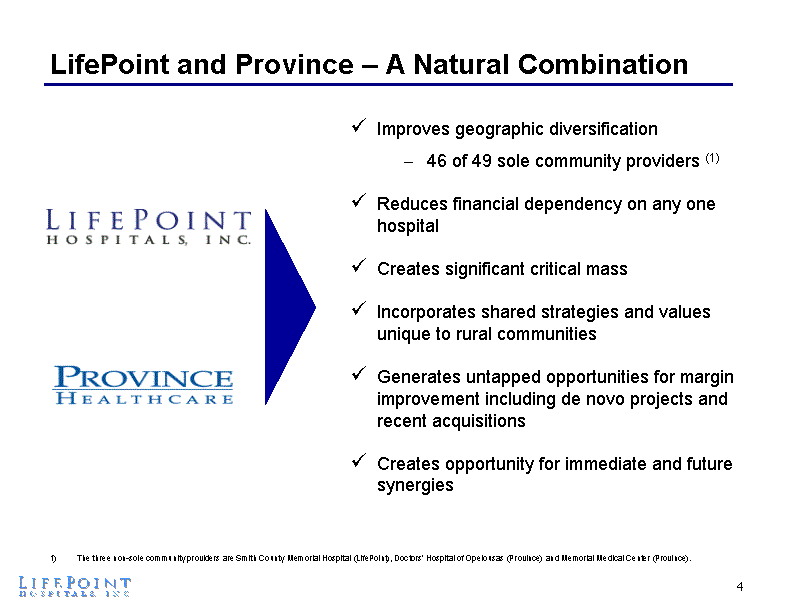
| LifePoint and Province - A Natural Combination Improves geographic diversification 46 of 49 sole community providers (1) Reduces financial dependency on any one hospital Creates significant critical mass Incorporates shared strategies and values unique to rural communities Generates untapped opportunities for margin improvement including de novo projects and recent acquisitions Creates opportunity for immediate and future synergies The three non-sole community providers are Smith County Memorial Hospital (LifePoint), Doctors' Hospital of Opelousas (Province) and Memorial Medical Center (Province). |

| Improves Geographic Diversification ¢ States Where Province Operates ¢ States Where Both LPNT & PRV Operate r Province Hospitals o LifePoint Hospitals Corporate Office ¢ States Where LifePoint Operates |
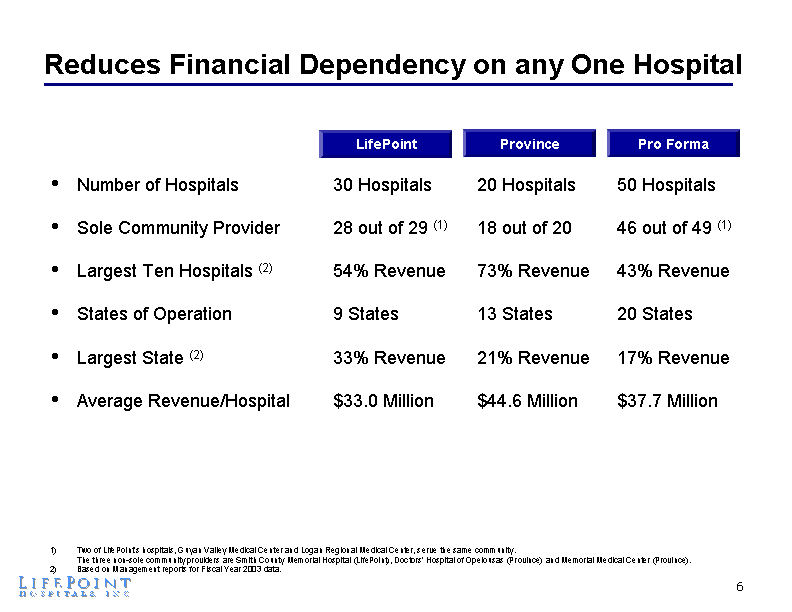
| Reduces Financial Dependency on any One Hospital Number of Hospitals 30 Hospitals 20 Hospitals 50 Hospitals Sole Community Provider 28 out of 29 (1) 18 out of 20 46 out of 49 (1) Largest Ten Hospitals (2) 54% Revenue 73% Revenue 43% Revenue States of Operation 9 States 13 States 20 States Largest State (2) 33% Revenue 21% Revenue 17% Revenue Average Revenue/Hospital $33.0 Million $44.6 Million $37.7 Million 1) Two of LifePoint's hospitals, Guyan Valley Medical Center and Logan Regional Medical Center, serve the same community. The three non-sole community providers are Smith County Memorial Hospital (LifePoint), Doctors' Hospital of Opelousas (Province) and Memorial Medical Center (Province). 2) Based on Management reports for Fiscal Year 2003 data. LifePoint Province Pro Forma |
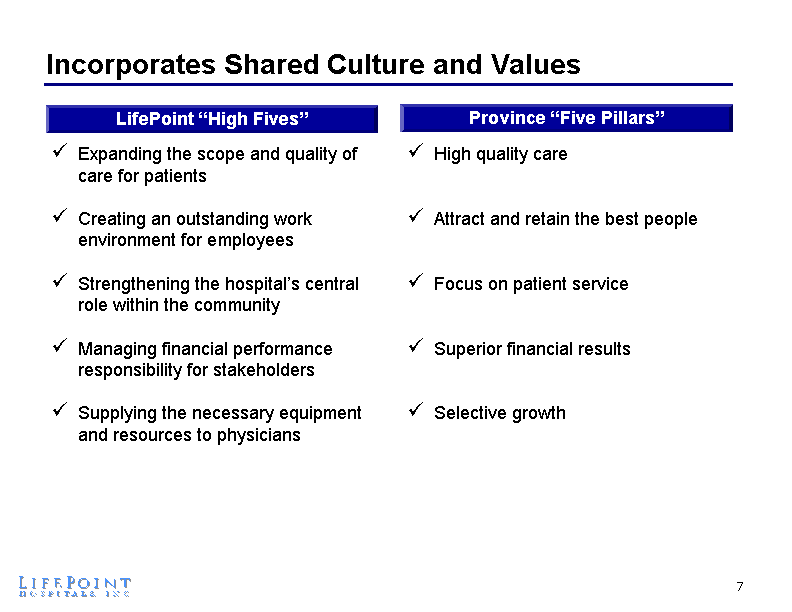
| Incorporates Shared Culture and Values Expanding the scope and quality of care for patients Creating an outstanding work environment for employees Strengthening the hospital's central role within the community Managing financial performance responsibility for stakeholders Supplying the necessary equipment and resources to physicians High quality care Attract and retain the best people Focus on patient service Superior financial results Selective growth LifePoint "High Fives" Province "Five Pillars" |
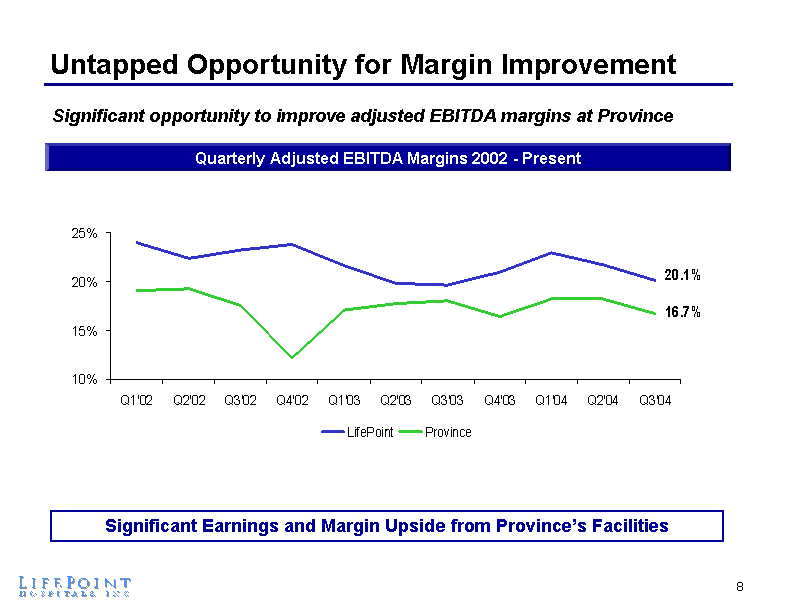
| Untapped Opportunity for Margin Improvement Significant Earnings and Margin Upside from Province's Facilities Quarterly Adjusted EBITDA Margins 2002 - Present Significant opportunity to improve adjusted EBITDA margins at Province |
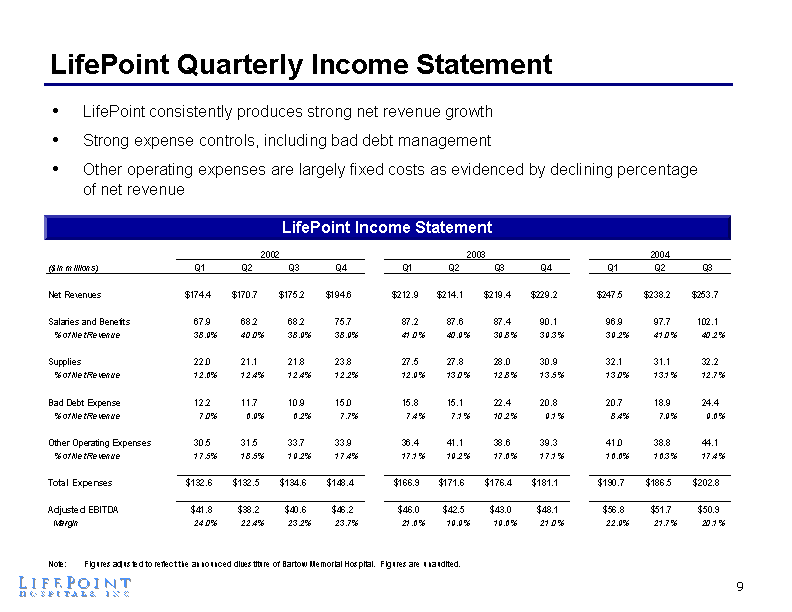
| LifePoint Quarterly Income Statement LifePoint Income Statement Note: Figures adjusted to reflect the announced divestiture of Bartow Memorial Hospital. Figures are unaudited. LifePoint consistently produces strong net revenue growth Strong expense controls, including bad debt management Other operating expenses are largely fixed costs as evidenced by declining percentage of net revenue |
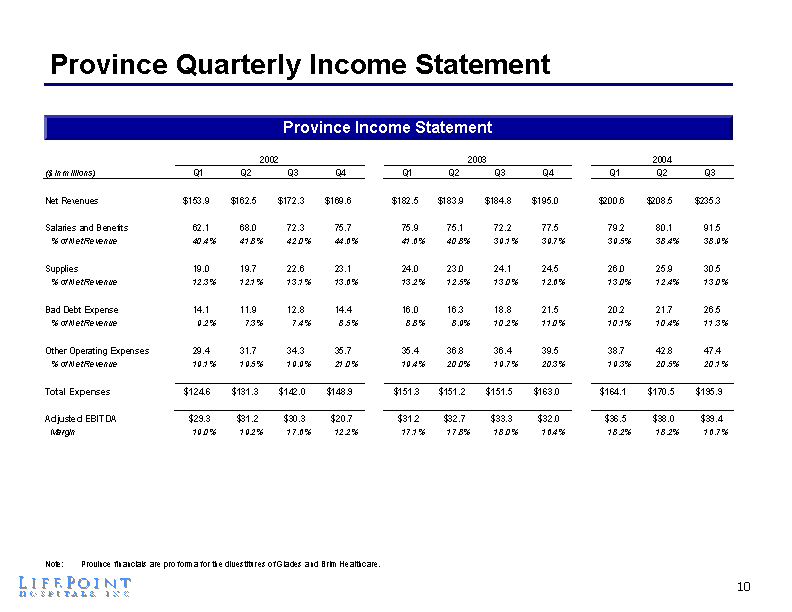
| Province Quarterly Income Statement Province Income Statement Note: Province financials are pro forma for the divestitures of Glades and Brim Healthcare. |
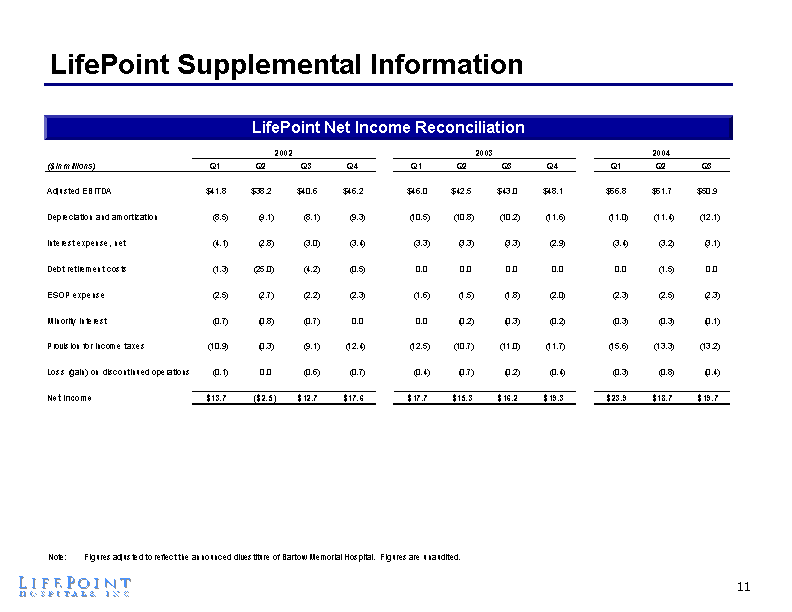
| LifePoint Supplemental Information LifePoint Net Income Reconciliation Note: Figures adjusted to reflect the announced divestiture of Bartow Memorial Hospital. Figures are unaudited. |
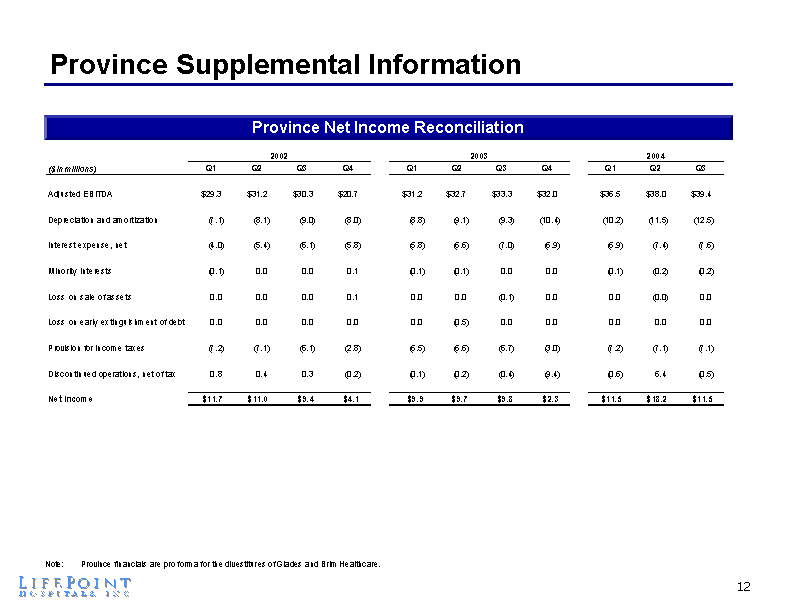
| Province Supplemental Information Province Net Income Reconciliation Note: Province financials are pro forma for the divestitures of Glades and Brim Healthcare. |
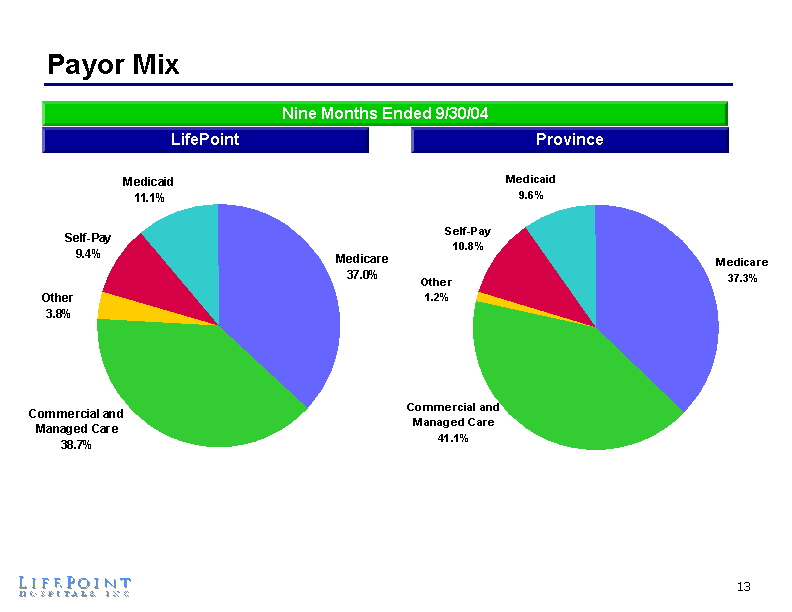
| Payor Mix LifePoint Province Nine Months Ended 9/30/04 |
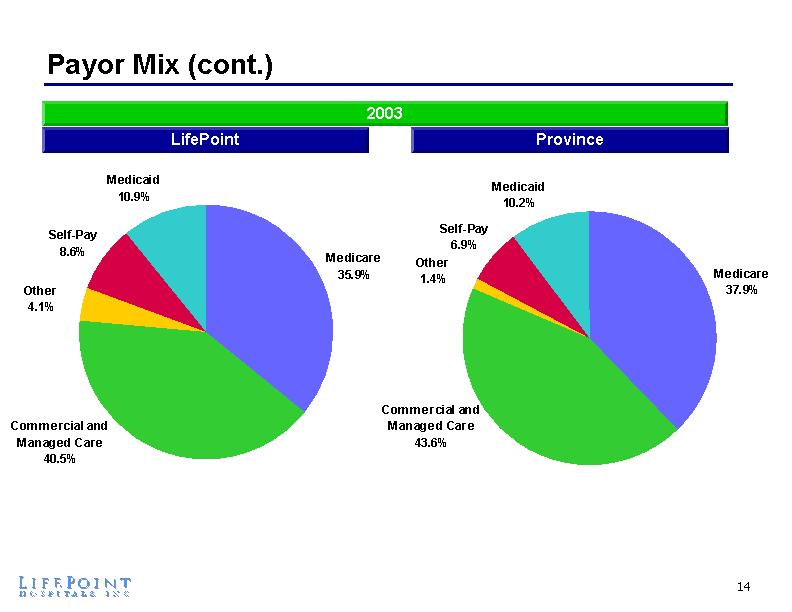
| Payor Mix (cont.) LifePoint Province 2003 |

| Opportunity for Immediate and Future Synergies Synergy Opportunities Nashville Offices Retirement Plan Physician Recruiting Development Regional Operating Structure Group Purchasing Managed Care Contracts |
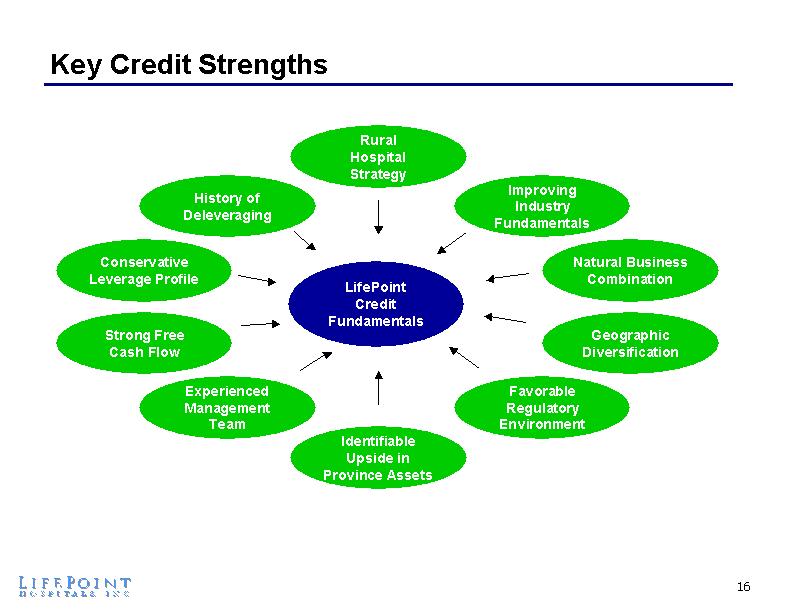
| Key Credit Strengths LifePoint Credit Fundamentals Rural Hospital Strategy Geographic Diversification Favorable Regulatory Environment Identifiable Upside in Province Assets Conservative Leverage Profile Strong Free Cash Flow History of Deleveraging Improving Industry Fundamentals Experienced Management Team Natural Business Combination |
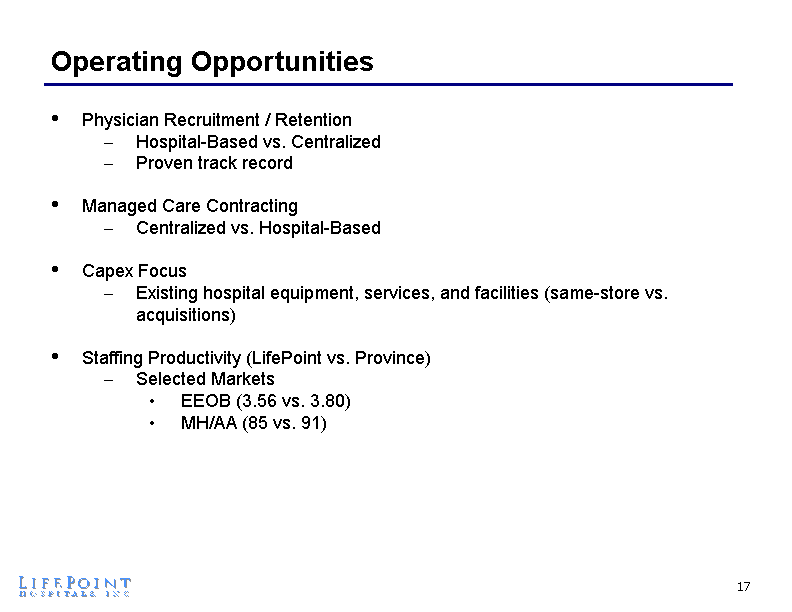
| Operating Opportunities Physician Recruitment / Retention Hospital-Based vs. Centralized Proven track record Managed Care Contracting Centralized vs. Hospital-Based Capex Focus Existing hospital equipment, services, and facilities (same-store vs. acquisitions) Staffing Productivity (LifePoint vs. Province) Selected Markets EEOB (3.56 vs. 3.80) MH/AA (85 vs. 91) |
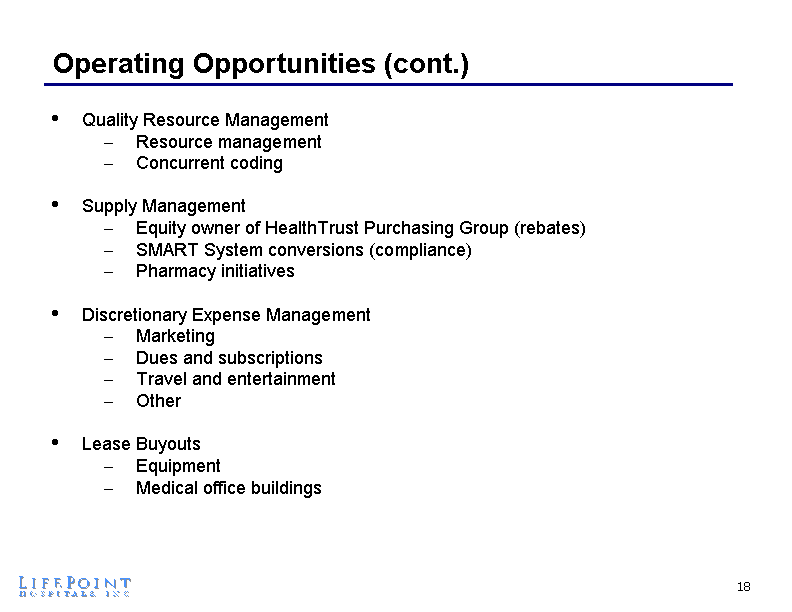
| Operating Opportunities (cont.) Quality Resource Management Resource management Concurrent coding Supply Management Equity owner of HealthTrust Purchasing Group (rebates) SMART System conversions (compliance) Pharmacy initiatives Discretionary Expense Management Marketing Dues and subscriptions Travel and entertainment Other Lease Buyouts Equipment Medical office buildings |
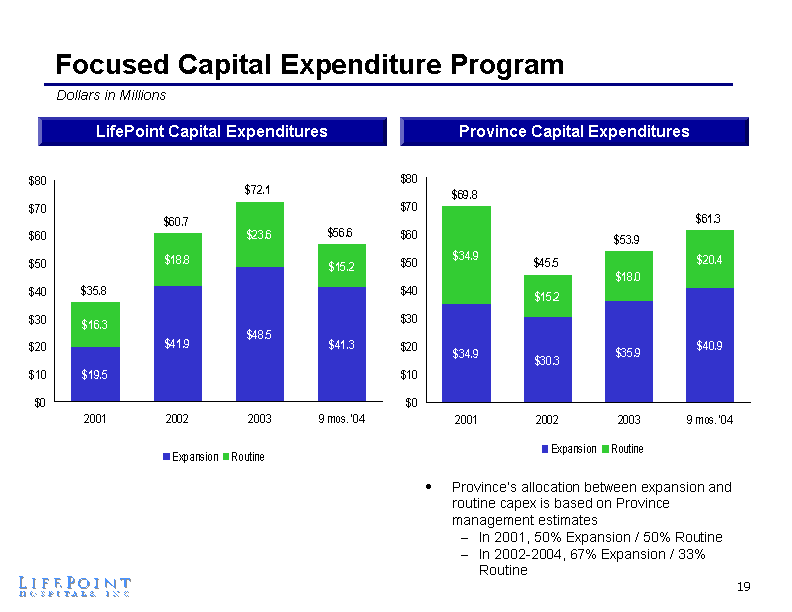
| Focused Capital Expenditure Program LifePoint Capital Expenditures Province Capital Expenditures Dollars in Millions Province's allocation between expansion and routine capex is based on Province management estimates In 2001, 50% Expansion / 50% Routine In 2002-2004, 67% Expansion / 33% Routine |
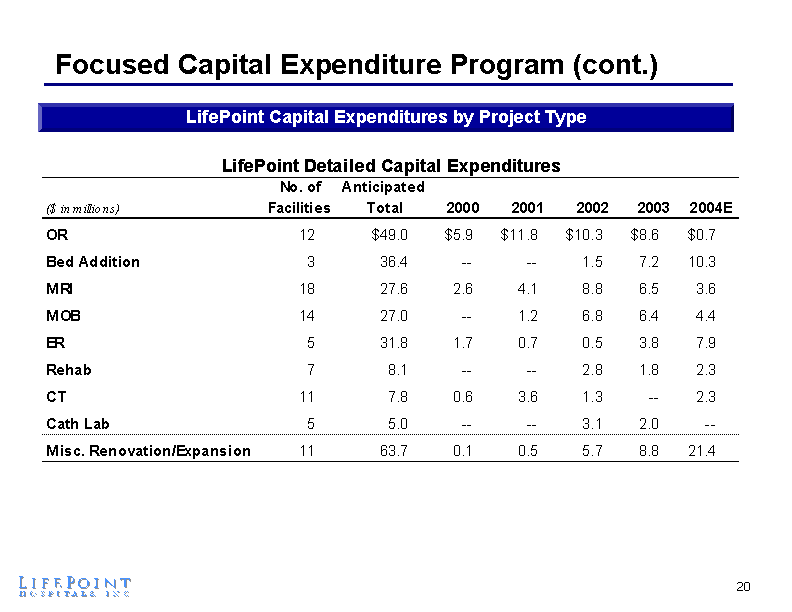
| Focused Capital Expenditure Program (cont.) LifePoint Capital Expenditures by Project Type |

| Physician Recruitment and Retention We will focus on recruiting and retaining the appropriate mix of primary care and specialist physicians to drive same store revenue Focus on unique physician needs at each hospital Our combined record recruiting year in 2003 and 2004 will drive same store revenues Recruiting Program Note: Represents admitting physicians only. |
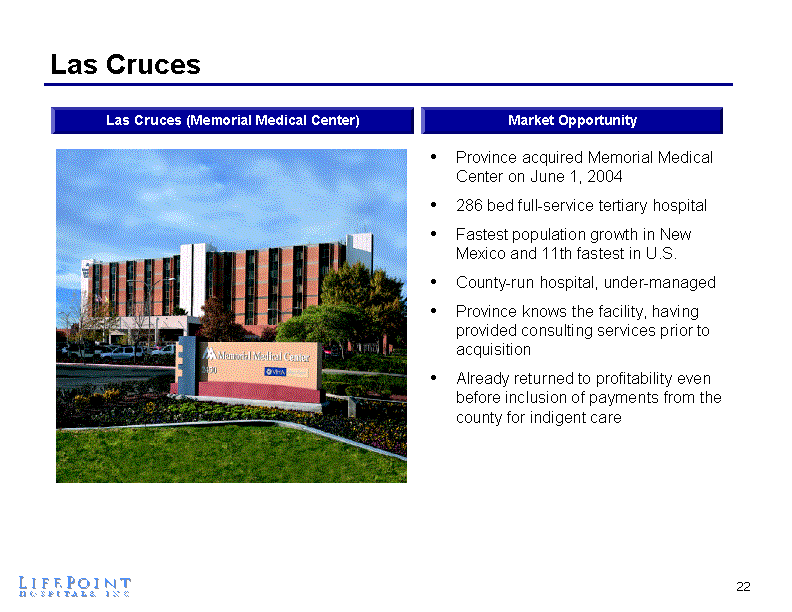
| Las Cruces Market Opportunity Las Cruces (Memorial Medical Center) Province acquired Memorial Medical Center on June 1, 2004 286 bed full-service tertiary hospital Fastest population growth in New Mexico and 11th fastest in U.S. County-run hospital, under-managed Province knows the facility, having provided consulting services prior to acquisition Already returned to profitability even before inclusion of payments from the county for indigent care |
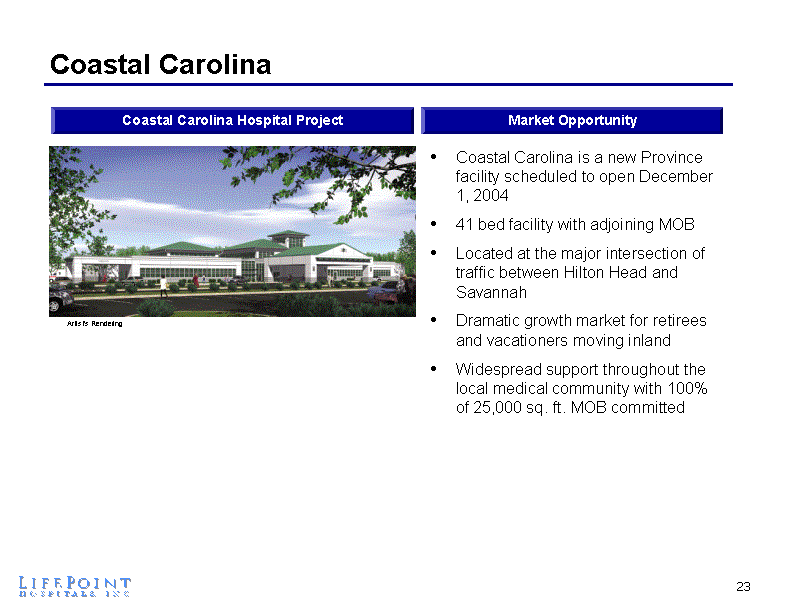
| Coastal Carolina Market Opportunity Coastal Carolina Hospital Project Coastal Carolina is a new Province facility scheduled to open December 1, 2004 41 bed facility with adjoining MOB Located at the major intersection of traffic between Hilton Head and Savannah Dramatic growth market for retirees and vacationers moving inland Widespread support throughout the local medical community with 100% of 25,000 sq. ft. MOB committed Artist's Rendering |
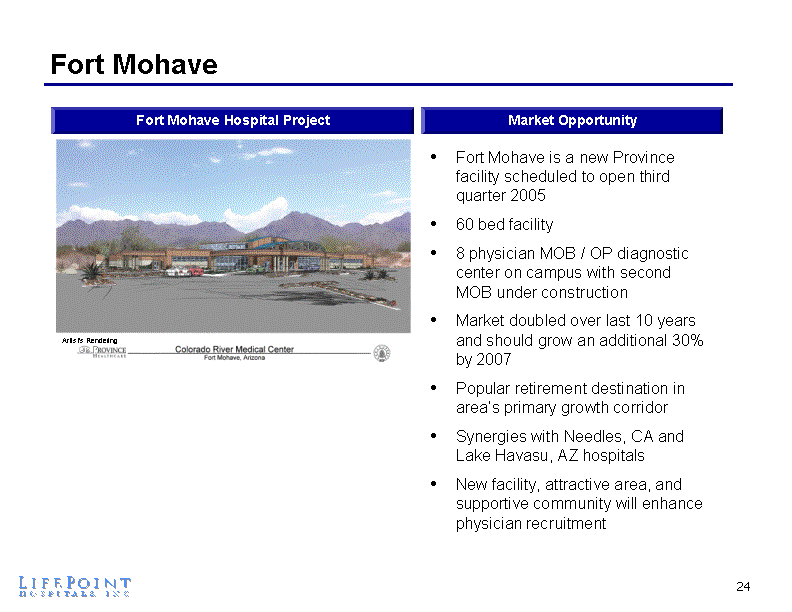
| Fort Mohave Market Opportunity Fort Mohave Hospital Project Fort Mohave is a new Province facility scheduled to open third quarter 2005 60 bed facility 8 physician MOB / OP diagnostic center on campus with second MOB under construction Market doubled over last 10 years and should grow an additional 30% by 2007 Popular retirement destination in area's primary growth corridor Synergies with Needles, CA and Lake Havasu, AZ hospitals New facility, attractive area, and supportive community will enhance physician recruitment Artist's Rendering Cover up |
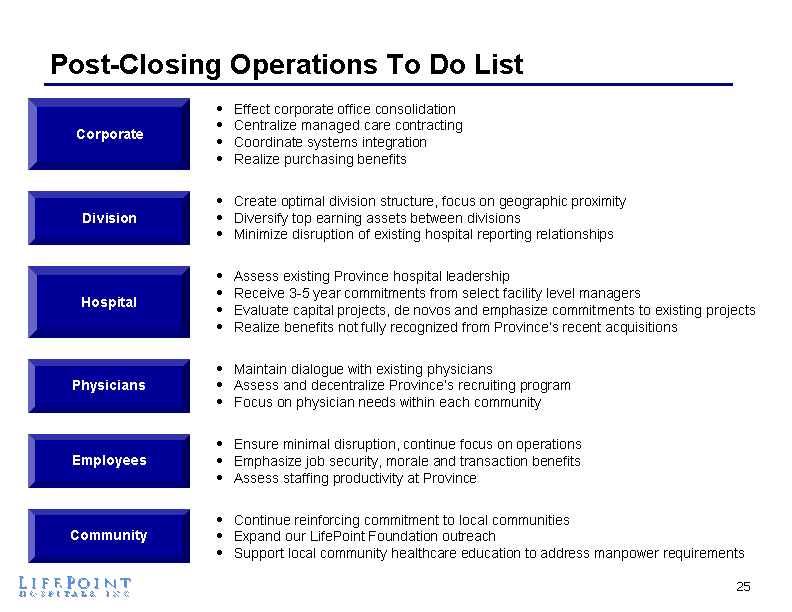
| Post-Closing Operations To Do List Physicians Hospital Effect corporate office consolidation Centralize managed care contracting Coordinate systems integration Realize purchasing benefits Create optimal division structure, focus on geographic proximity Diversify top earning assets between divisions Minimize disruption of existing hospital reporting relationships Assess existing Province hospital leadership Receive 3-5 year commitments from select facility level managers Evaluate capital projects, de novos and emphasize commitments to existing projects Realize benefits not fully recognized from Province's recent acquisitions Maintain dialogue with existing physicians Assess and decentralize Province's recruiting program Focus on physician needs within each community Ensure minimal disruption, continue focus on operations Emphasize job security, morale and transaction benefits Assess staffing productivity at Province Continue reinforcing commitment to local communities Expand our LifePoint Foundation outreach Support local community healthcare education to address manpower requirements Corporate Division Employees Community |
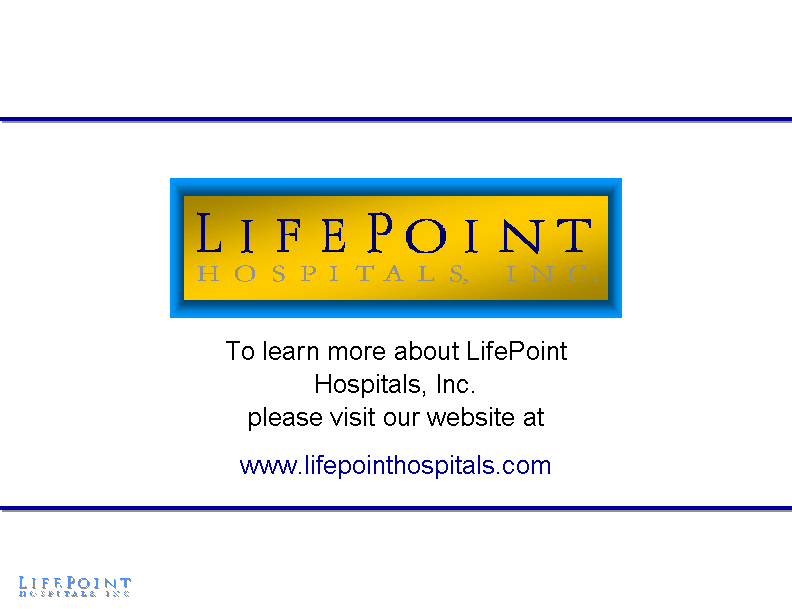
| To learn more about LifePoint Hospitals, Inc. please visit our website at www.lifepointhospitals.com |
PROVICNE HEALTHCARE CO.
Moderator: Pam Hunter
October 28, 2004/10:00 a.m. CDT
Page 1
PROVINCE HEALTHCARE CO.
October 28, 2004
10:00 a.m. CDT
| | | |
| Coordinator | | Good morning, and welcome to the Province Healthcare Third Quarter Earnings conference call. At this time all participants are in a listen-only mode. After the presentation we will conduct a question and answer session. Today’s conference is being recorded. If you have any objections, you may disconnect at this time. |
| | | |
| | Now we’ll turn the meeting over to Ms. Pam Hunter, Vice President of Investor Relations. Ma’am, you may begin. |
| | | |
| P. Hunter | | Thank you, Jan, and you thank you all for joining us today. Good morning, everyone. I’m Pam Hunter, Vice President Investor Relations for Province Healthcare. We’re here to discuss the company’s third quarter and year-to-date results, which were reported yesterday afternoon after the market closed. With me are Marty Rash, Chairman and Chief Executive Officer; Dan Slipkovich, President and Chief Operating Officer; and Chris Hannon, Senior Vice President and Chief Financial Officer.
Before we begin, I want to extend a special welcome to those of you who are joining us through the Webcast. This call will be archived on the company’s Web site for thirty days and you can access the Web site at www.prhc.net. |
| | | |
| | Now just a word about procedures. After our formal remarks we’ll be glad to take your questions. The MCI operator will instruct you on the procedures at that time. Also, please note that in this morning’s call, we will reiterate forward-looking statements that were made in the press release. |
PROVICNE HEALTHCARE CO.
Moderator: Pam Hunter
October 28, 2004/10:00 a.m. CDT
Page 2
| | | |
| | In accordance with Safe Harbor provisions of the Private Securities Litigation Reform Act of 1995, we would like to call your attention to the risks related to these statements, which are more fully described in the press release and in the company’s filings with the Securities and Exchange Commission. But these formalities out of the way, I’ll turn the call over to Marty Rash. |
| | | |
| M. Rash | | Yes. Thank you. I’d like to welcome everybody to the Province Healthcare conference call today. Yesterday we reported our third quarter results for the company. Diluted earnings per share from continuing operations were $0.23, compared to $0.21 in the prior year. |
| | | |
| | A number of noteworthy events in the quarter. Memorial Medical Center in Las Cruces, New Mexico has proven to be a strong performer, as evidenced by our consolidated net patient revenue growth of 27.6%; admission growth 11.4%; adjusted admission growth of 14.1%; and surgery growth of 26.9%. By the way, Memorial Hospital is currently running at about 18% EBITDA margin, which is outstanding for a new acquisition that had previously operated at a negative margin. |
| | | |
| | Cash flow from operations continues to exceed all expectations, with $44.3 million in the third quarter representing the 25.5% increase over the prior period. Same-store net patient revenue for the quarter grew a strong 5.5 %; same-store net patient revenue for adjusted admission increased 4.8%; same-store surgeries increased a strong 4.1%; and same store adjusted admissions were up 0.7%. We continue to see strong double-digit growth in gross outpatient revenues, with an 11.8% increase quarter over quarter. Same-store acuity increased to 1.22% this quarter from 1.20% in the prior year quarter. |
PROVICNE HEALTHCARE CO.
Moderator: Pam Hunter
October 28, 2004/10:00 a.m. CDT
Page 3
| | | |
| | Province ended the quarter with 20 owned or leased hospitals, of which 19 are same-store hospitals. |
| | | |
| | I’d also like to briefly update you on two other new hospital projects. Coastal Carolina Medical Center in Hardeeville, South Carolina, will have a public grand opening ceremony and facility tour on November 6th, and we will begin admitting patients to the hospital on or about December 1st. This is ahead of where we had indicated earlier. We thought we would be scheduled to open. The hospital was originally scheduled to open in early 2005, and we are extremely pleased to be able to open earlier than we had planned. |
| | | |
| | The accelerated opening results in higher than expected startup costs in the third quarter, and will also result in a higher level of expenses in the fourth quarter. Total startup expenses for the project are in line with our original budget, but have just been incurred in earlier periods due to the earlier opening. |
| | | |
| | The new medical office building on the hospital campus currently under construction by a third-party developer is leased to capacity. Physician suites build out is currently underway, and the first group of tenants is scheduled to move into the building in mid-November. |
| | | |
| | Valley View Medical Center in Ft. Mohave, Arizona is currently under construction. This 60-bed facility is expected to open during the third quarter of ‘05. A second medical office building on the campus is under construction by a third-party developer, and is expected to be completed by early 2005, and to refresh your memory, there is already an existing medical office building on this site that has been there for a couple of years and is full. |
PROVICNE HEALTHCARE CO.
Moderator: Pam Hunter
October 28, 2004/10:00 a.m. CDT
Page 4
| | | |
| | We have exceeded our physician recruiting goal of approximately 90 physicians for the year. To date we have recruited 104 physicians that will start in 2004 in our communities, of which 79 have begun to practice, and 25 are committed to commence practice in the final quarter of the year. |
| | | |
| | Over two-thirds of these physicians are specialists. Year to date the company has lost on 27 significant physicians, which demonstrates the company’s continued success in key physician retention. Significant physicians are those physicians that generate over $200,000 of gross revenue over the previous twelve months. |
| | | |
| | As you know, we have signed a definitive agreement to be acquired by LifePoint Hospitals, Inc., and the transition is expected to close in the first quarter of 2005. We are working closely with LifePoint to make sure this transition goes as smoothly as possible for our employees, our patients, and our communities. |
| | | |
| | In reviewing, as a result this is likely to be our last public call. In February of 1998, Province went public at a split-adjusted price of $7.11. Yesterday our stock price was $21.85. That represents 207% growth in share value over the public life of our company or an implied average annual growth rate of 31% in the life of our company. Our revenues grew from $220 million in 1998 to $746 million in ‘03, representing a 28% compound annual growth rate over that same six-year period. |
| | | |
| | I’d like to take a moment to, first of all, thank our employees. These results are directly a result of our employees and our physician efforts in our communities. You all have made a great difference in these communities, and thank you for that effort. It has been |
PROVICNE HEALTHCARE CO.
Moderator: Pam Hunter
October 28, 2004/10:00 a.m. CDT
Page 5
| | | |
| | tremendous. I’d like to take a moment to thank our shareholders for their support over that six-year period of time, and thank you all for the dedication to our company. |
| | | |
| | With all that said, I’d like to turn the call over to Dan Slipkovich for his comments. |
| | | |
| D. Slipkovich | | Thank you, and thank everyone on the call for joining us this morning. Today I will discuss the financial results and financial position of the company for the three months and nine months ended September 30, 2004. |
| | | |
| | Province acquired Memorial Medical Center in Las Cruces, New Mexico effective June 1st. We continue to be very excited about the prospects of this acquisition, as it has well exceeded our expectations in the initial four months of our ownership. |
| | | |
| | In my presentation, all consolidated financial information and analysis will be related to our 20 existing hospitals and corporate operations that are reported as continuing operations. All same-store financial information and analysis relates to our 19 hospitals, excluding Las Cruces and excluding corporate expenses. |
| | | |
| | For the quarter ended September 30, 2004, on a consolidated basis revenues increased 27.3% to $235.3 million, compared to $184.8 million in the prior year’s quarter. Adjusted EBITDA increased 19.4% to $42.4 million, compared to $35.6 million in last year’s third quarter. |
| | | |
| | From continuing operations, net income for the quarter was $11.9 million or $0.23 per diluted common share, compared to last year’s net income of $10.2 million or $0.21 per diluted share. |
PROVICNE HEALTHCARE CO.
Moderator: Pam Hunter
October 28, 2004/10:00 a.m. CDT
Page 6
| | | |
| | For the nine-months ended September 30, 2004 on a consolidated basis, revenues increased 16.9% to $644.4 million, compared to $551.2 million in the prior year’s period. Adjusted EBITDA increased 17.7% to $122.3 million, compared to $103.9 million in the prior year’s period. |
| | | |
| | In continuing operations, net income for the period was $35.9 million or $0.70 per diluted common share, compared to last year’s net income of $30 million or $0.61 per diluted share, a 14.8% increase. |
| | | |
| | The two convertible note issues are diluted for the three- and nine-month periods ended September 30, 2004, and anti-diluted for the three and nine month periods ended September 30, 2003. Therefore, for the three- and nine-month periods ended September 30, 2004, EPS is calculated on the if-converted method. |
| | | |
| | The details of the if-converted method calculation are provided in the footnotes of our press release. We anticipate that the two-convertible issues will be diluted on a go-forward basis. |
| | | |
| | In the 19 same-store hospitals for the quarter, adjusted admissions grew seven-tenths of a percent, in-patient admissions decreased 3%, surgeries increased 4.1% from the third quarter of last year. Same-store net revenue increased 5.5%, while outpatient revenue increased 11.8%. |
| | | |
| | Compared to the prior year third quarter on a same-store basis, net revenue per adjusted admission increased 4.8% and net revenue per admission increased 8.8%. The increase in that revenue per adjusted admission and in-patient admission were driven by improved |
PROVICNE HEALTHCARE CO.
Moderator: Pam Hunter
October 28, 2004/10:00 a.m. CDT
Page 7
| | | |
| | pricing and by acuity, as the company’s Medicare case mix improved 1.7% quarter over quarter, to 1.22% from 1.20%. |
| | | |
| | The company’s recruitment success over the previous two years, focusing on bringing needed specialists to our market, has resulting in tremendous growth and higher acuity specialty admissions. On a same-store basis, compared to the prior year’s quarter, Province has experienced specialty admission trends in the following areas: cardiology was up 16.1%; general surgery up 7.3%; ob-gyn up 5%; nephrology up 74%; neurology up 46.9%; orthopedics up 15.3%, and urology up 4.8%. |
| | | |
| | Offsetting this higher acuity specialty admission has a been a decline in lower acuity admissions of internal medicine and family practice physicians from existing practices of 7.3%, and a decrease in ob-gyn admissions of 5.6%, specifically in two markets from the temporary closing of ob units due to physician losses. |
| | | |
| | The company’s continued growth in 2004 will be driven by: 1), the continued maturing of our ‘02 and ‘03 recruited physicians; 2) the growth of physicians that have started and been signed in ‘04; and 3), the impact of our revenue generating projects. |
| | | |
| | Our same-store payer and exchanges from prior year quarter are as follows: Medicare remained at approximately 38% of our net revenue, Medicaid declined from 11.0% of net revenue to 9.5%, and other payers, primarily third-party insurance companies, increased from 50.9% to 52.5% of net patient revenue. The other payer category also includes self-pay revenue. The company, similar to the entire industry, has experienced an increase in self-pay since the beginning of ‘03. In the third quarter same-store self-pay increased to 5.2% of gross revenue compared to 4.8% in the prior year quarter. However, on a |
PROVICNE HEALTHCARE CO.
Moderator: Pam Hunter
October 28, 2004/10:00 a.m. CDT
Page 8
| | | |
| | sequential basis the percentage of same-store self pay, gross revenue declined from 5.5% in the second quarter to 5.2% in the third. |
| | | |
| | We continue to see the level of self-pays, the percentage from gross revenue buffers the historical levels due to the economic environment, resulting in slow employment recovery, coupled with the adverse changes to benefit plan design of increased co-pays and deductibles, as employers pass a greater percentage of healthcare costs to the individual employee. |
| | | |
| | Where we have seen the majority of the economies we serve stabilize in recent quarters, we are also seeing the reduction of coverage in state Medicaid. We will continue to monitor the self-pay revenue category closely. |
| | | |
| | Compared to the prior year quarter, on a same-store basis bad debt expense increased approximately 90 basis points from 10.2% to 11.1% of revenues. On a consolidated basis bad debt expense increased approximately 110 basis points, from 10.2% to 11.3%. The increase in same-store bad debt expense was driven primarily by the reduction in coverage in state Medicaid programs, primarily in Texas. |
| | | |
| | On a consolidated basis, Province also was impacted by Las Cruces, whose bad debt runs at a level above our company average. On a same-store basis in the quarter, as a percentage of net revenue, charity plus bad debt expense remained level at 13.0%. A 1.7% decline in charity offset the previously discussed increase in bad debt expense. |
| | | |
| | Expense totals in the third quarter compared to the prior year quarter are reflective of the continued emphasis that Province has placed on cost controls over the last six quarters. |
PROVICNE HEALTHCARE CO.
Moderator: Pam Hunter
October 28, 2004/10:00 a.m. CDT
Page 9
| | | |
| | Expenses as a percentage of revenues remained relatively consistent for the quarter compared to the prior year, except for the increase in bad debt expense previously outlined. |
| | | |
| | The focus on controls allowed the company to improve its adjusted EBITDA margin for the nine-month period by approximately 15 basis point to 19.0% on a consolidated basis, and by approximately 60 points on a same-store basis. For the quarter, the consolidated adjusted EBITDA margin equaled 18.0%, compared to 19.2% in the prior year quarter. |
| | | |
| | The decrease in margin is the result of three primary factors: 1), although the Las Cruces acquisition continues to exceed our expectations, its adjusted EBITDA margin continues to dilute our overall margin in the short-term; 2), Hurricane Ivan impacted two of our facilities, for a total EBITDA dilution of approximately $650,000; and 3), the pre-opening cost of our Jasper County Hospital resulted in approximately $800,000 of EBITDA loss in the quarter. |
| | | |
| | Now let me give you the quick update on construction projects. We’re adding a MRI and renovating nuclear medicine at Lake Havasu Regional Medical Center. This $2.6 million project will be completed in the first quarter of 2005. We are also in the planning stages of developing an open-heart program in the Havasu market. |
| | | |
| | We have completed the addition of six med surg beds at Doctors’ Hospital, which were placed into service in the second quarter. With the continued on outpatient services, plans are in place to expand the ambulatory surgery unit and outpatient area in its medical center, with the completion planned for the first quarter in 2005. Plans have begun to expand and renovate the outpatient area and ER at Palestine Regional Medical Center. |
PROVICNE HEALTHCARE CO.
Moderator: Pam Hunter
October 28, 2004/10:00 a.m. CDT
Page 10
| | | |
| | At Los Alamos Medical Center, a new MRI was completed in February, and plans have begun on a $3.7 million project to renovate and expand the ER and outpatient areas. This project is scheduled to begin in the fourth quarter ‘04, and will be completed in approximately eight months.
At Martinsville, a $6.8 million patient floor renovation has begun and will take approximately 22 months to complete. We are also in the planning stages for an outpatient surgery center in the Martinsville market. |
| | | |
| | At Minden Medical Center, a $1.8 million MRI renovation project was completed in October 2004. At Elko, a $3.3 million project to upgrade MRI and to build out a swing lab has been planned. The swing lab, in fact, was opened in third quarter of this year and MRI completion is expected for early 2005. |
| | | |
| | Construction has been completed on the ob unit at Teche Regional Medical Center, where seven new labor and delivery rooms were added and a new nursery was created. At Vaughan Regional Medical Center in Selma, final plans are being developed for a new surgery center addition. |
| | | |
| | Our continued physician recruiting has driven the need for additional medical office buildings. Plans continue for third-party development of office buildings at Ashland Regional, Medical Center of Southern Indiana, Memorial Hospital of Martinsville, Starke Medical Center, Colorado Plains Medical Center, Minden Medical Center and Las Cruces. |
PROVICNE HEALTHCARE CO.
Moderator: Pam Hunter
October 28, 2004/10:00 a.m. CDT
Page 11
| | | |
| | Construction has begun by a third-party developer on our office building for Coastal Carolina Medical Center, Colorado Plains Medical Center and Valley View Medical Center in Ft. Mohave, Arizona. |
| | | |
| | In the fourth quarter of 2004, the company will close the acquisition of an additional site in Boston, South Carolina for the development for a second MOB for the Coastal Carolina Medical Center, which we expect to be completed in 2005. We’ll meet the needs of our recruited physicians in these markets without having to invest our own capital by using third-party developers for the medical office buildings. |
| | | |
| | I’d like to now thank our hospital corporate and regional teams for the results of this third quarter. During this time of transition, our teams continue to stay focused. It would be very easy to worry about the transition, and I hope you all will recognize that, in fact, our folks are staying focused. So thank you very much. |
| | | |
| | Chris, now I’ll turn it over to you, and I know you’ll talk about the P&L below the EBITDA line and balance sheet and cash flow. |
| | | |
| C. Hannon | | Thank you, Dan and Marty, and I thank each of you for joining us on the call today. Through the quarter interest expense increased approximately $600,000 compared to prior year, driven by the addition debt associated with the acquisition of Las Cruces, and has been offset by the reduction of approximately $10 million of debt we paid during the quarter as a result of our strong cash flow generation. |
| | | |
| | The quarter depreciation expense increased $3.3 million from the prior year’s quarter. Approximately $1.8 million of this increase is a result of the additional expense |
PROVICNE HEALTHCARE CO.
Moderator: Pam Hunter
October 28, 2004/10:00 a.m. CDT
Page 12
| | | |
| | associated with the acquisition of Las Cruces, and the remaining increase is a result of the company’s capital expenditure program focusing on revenue-generated projects. |
| | | |
| | The company’s financial condition remains very strong. On September 30, 2004, Province had approximately $11.6 million in cash and cash equivalence. Net AR at the end of the quarter increased approximately $28.5 million from the fiscal year-end 2003 level, to $138.8 million, primarily resulting from the Las Cruces acquisition. |
| | | |
| | Note that the allowance for ... accounts decreased slightly as a percentage of gross AR from fiscal year-end 2003, from 37.7 to 36.9 %. Same-store net days in accounts receivable remained stable at 55 days, with consolidated days improving to 52 days from the fiscal year-end 2003 level of 54. |
| | | |
| | As previously indicated, Province continues to improve its collection cycle, and believes that the DSOs are at a sustainable level on an ongoing basis with seasonal variations. This company will now continue to see the dramatic improvement in DSOs that have been achieved over the previous 36 months, as we are approaching what should be a sustainable level for our industry. |
| | | |
| | At September 30, 2004, total assets were approximately $1.2 billion and debt to capitalization was 50.8%, a slight increase from 50.1% at fiscal year-end 2003, primarily due to the acquisition of the World Medical Center in Las Cruces. The company currently maintains a $250 million revolver, of which approximately $187 million is available for acquisition activity and general corporate purposes. This is net of an additional $10 million repayment on the revolver, which was made as of today. |
PROVICNE HEALTHCARE CO.
Moderator: Pam Hunter
October 28, 2004/10:00 a.m. CDT
Page 13
| | | |
| | Cash flow from operations was a very strong $44.3 million for the third quarter, representing a 25.5% increase over the prior year period. Cash flow from operations funded capital expenditures for the period of $23.6 million, compared to $13.5 million in capital expenditures in the prior year period. These expenditures consisted primarily of $7.4 million for the construction of the Coastal Carolina Medical Center, including $3.4 million of new equipment, $1.4 million for the Teche ob renovation, $2.4 million for the Los Alamos MRI and facility renovations, and $1.6 million for the construction of Valley View Medical Center in Ft. Mohave. |
| | | |
| | Through the nine-month period, Province has generated $93.1 million in cash flow from operations, in line with our expectations. For the initial nine-month period of 2004, cash flow from operations funded approximately $61.3 million in capital expenditures, compared to $43.9 million in the 2003 period. |
| | | |
| | For the nine-month period capital expenditures consisted primarily of $16.3 million for the construction of Coastal Carolina Medical Center; $6.3 million for the acquisition of land at Havasu for the future expansion of the Havasu operations; $4.8 million for the Los Alamos MRI and facility renovations; $3.1 million for the Teche ob renovation; and $2.6 million for the construction of the Valley View Medical Center. |
| | | |
| | Our strong cash flow over the last two years has allowed the company to fund our capital expenditure program, with approximately two-thirds of the expenditures for revenue generating projects, including new and/or updated equipment, several significant construction projects, and near completion of a new hospital project in Hardeeville, South Carolina. |
PROVICNE HEALTHCARE CO.
Moderator: Pam Hunter
October 28, 2004/10:00 a.m. CDT
Page 14
| | | |
| | The ongoing construction of the new hospital project in Ft. Mohave, Arizona, and a purchase of a highly successful $153 million acquisition in Las Cruces, New Mexico, all of these expenditures were done with only the net addition of $55 million in revolver borrowings as of today. |
| | | |
| | For the quarter, cash collections as a percentage of net revenue continued to exceed 100%, and we experienced an 8.8% increase over the prior year quarter in same-store front-end cash collections. During the nine-month period, Province has experienced a 24.3% increase in same-store upfront cash collections. Also, over the last seven quarters Province has collected over 20% of its net self-pay revenue in upfront cash collections. |
| | | |
| | This concludes the company’s formal comments, but before I turn the call over to Pam, I would like to take the opportunity to thank our shareholders for your support. Also, I want to thank every member of the Province team for you hard work and commitment to this company’s success. I personally have never worked with a finer group of people. As Marty has said, it’s been a great ride. |
| | | |
| | I’ll now turn the call back over to Pam, and we’ll take any questions that you might have. |
| | | |
| P. Hunter | | We’ll be happy to open up the call for questions at this time. |
| | | |
| Coordinator | | Our first question comes from David Dempsey with Avondale Partners. |
| | | |
| D. Dempsey | | Question for you on bad debts, a couple of parts of the question. Are there states outside of Texas where the Medicaid eligibility issue has caused more people to become uninsured and caused pressure on that, and then related to Memorial Medical Center; how |
PROVICNE HEALTHCARE CO.
Moderator: Pam Hunter
October 28, 2004/10:00 a.m. CDT
Page 15
| | | |
| | does the provision of the contract work when the county reimburses Province for certain bad debts? What’s the expected level of bad debts beyond which reimbursement occurs, and are we going to see any of that money that will kind of soften the blow of bad debts? |
| |
| D. Slipkovich | | First question, are we seeing other states squeezing like Texas is? We have seen Alabama, for instance; they reduced their total days of coverage to participants by two days per year. So you’re seeing that kind of phenomenon really across the country, and that’s fundamentally an issue of states having trouble balancing their budgets and having to obviously squeeze the Medicaid programs. |
| | | |
| | The Las Cruces question, I’m going to make sure I answer, is the funding is in line with what we expected. Las Cruces is running in the 12% bad debt range, which is pretty much as we had modeled coming into the transaction. So it’s really not anything significantly different than we had modeled on the front end of the transaction. |
| | | |
| D. Dempsey | | Okay. Then just one final thing. I know in the last quarter you added another million dollars to the provision for some higher than expected experience. Any additional one-time items added to the provision in this quarter. |
| | | |
| M. Rash | | There were no additional increases in our allowance. We did the same exhaustive analysis that we do every quarter, incorporating what we look at, 13 critical factors and the sufficiency of our allowance, and made no additional adjustments this quarter. |
| | | |
| D. Dempsey | | Okay. Thank you, guys. It’s been nice working with you. |
| | | |
| M. Rash | | Thank you, David. |
PROVICNE HEALTHCARE CO.
Moderator: Pam Hunter
October 28, 2004/10:00 a.m. CDT
Page 16
| | | |
| Coordinator | | Our next question comes from Adam Feinstein with Lehman Brothers. |
| | | |
| A. Feinstein | | Thank you. I just want to say congrats to everyone and really did a great job over the past six years, as Marty noted at the beginning of the call. |
| | | |
| | I have two questions. One, you had mentioned in the beginning of the call, if I heard you right, that the margin at Las Cruces was about 18%, and just by using that margin, if I try to back into a same-store margin, I get about 16%, but I just want to make sure that I’m looking at it right. Any commentary on that? |
| | | |
| M. Rash | | Our same-store margin, we do not include the corporate expenses. |
| | | |
| A. Feinstein | | Okay. |
| | | |
| C. Hannon | | We look at our same-store hospital or same-store information, but that number, we have never given out same-store EBITDA margins in the history of the company, so I don’t think we’re going to change that today. |
| | | |
| A. Feinstein | | Okay. Let me ask it a different way, Chris, then. The 18% margin you said for Las Cruces, was that a number for the quarter or was that a number in terms of where that margin is today? |
| | | |
| C. Hannon | | No. That’s the number for the quarter. |
| | | |
| A. Feinstein | | That’s the number for the quarter? |
PROVICNE HEALTHCARE CO.
Moderator: Pam Hunter
October 28, 2004/10:00 a.m. CDT
Page 17
| | | |
| C. Hannon | | That’s correct. |
| | | |
| A. Feinstein | | Okay. Just a second question on the bad debt. I guess just looking at the allowance on the balance sheet, it went down relative to the June quarter. It had gone up a lot in the June quarter. So we’re just trying to figure out what was driving that, and just wanted to see if that was also related to the Las Cruces facility? |
| | | |
| C. Hannon | | As a percentage, it was down slightly as a result of additional write-offs as you calculate the allowance. Obviously, the Las Cruces allowance is now incorporated in that consolidated number. So it does have an impact, but Las Cruces is, in our opinion, adequately reserved at this point in time for the acquired AR. |
| | | |
| A. Feinstein | | Okay. And then just one more question, if I may. I guess earlier in the year there was a lot of talk about Lake Havasu and potential competition. Any update there? We haven’t heard anything else about that. Just wanted to see what the latest was there and I’ll get off. Thank you. |
| | | |
| M. Rash | | Sure. A lot of that rhetoric and noise has calmed down a good deal, Adam. The physicians, I think probably a number of things have occurred. We have new management there, and there’s just been a general calming of the water, so to speak. |
| | | |
| A. Feinstein | | Okay. Thank you. |
| | | |
| Coordinator | | Our next question comes from Darren Lehrich with Piper Jaffray. |
| | | |
| D. Lehrich | | Just a couple of things here. I heard in your prepared remarks, as it relates to some of the capital projects you have going, several outpatient surgery projects over the next several |
PROVICNE HEALTHCARE CO.
Moderator: Pam Hunter
October 28, 2004/10:00 a.m. CDT
Page 18
| | | |
| | quarters, and it sounded like a few of those were surgery centers. So I guess, Marty, I just wanted to get your thoughts on whether you’re seeing an increase in physician-owned competition, if this is sort of a defensive thing, if these are not really surgery centers, but more outpatient expansions inside your hospitals. Just give us some thought on that, please, and then I have a follow up. |
| | | |
| M. Rash | | Really, the two that I’m ... and that we talked about significantly was Selma, and that really is a capacity issue more than anything. It’s not, I would say, driven by any market competition, that we’d really continue to grow surgery, and candidly it’s easier to look at an outpatient setting. It’s more, probably, efficient use of our capital to do that rather than trying to go back into the hospital to do so. |
| | | |
| | The Martinsville side actually will probably be an AFC wing within the hospital; somewhat the same thing, kind of reconfiguring and improving patient flow. In both of these instances, these are CON states; you know, we’ve got CONs for these projects so we’re supported by markets needs as defined by each of those states. |
| | | |
| D. Lehrich | | Okay. Then if I could, help us think a little bit about pricing. Going to ‘05, just want to get a sense for what Province, as they kind of model out in my LifePoint combined model here. Your book of business looks like Managed Care, Medicare, I guess, after October 1st, what the Medicare rates are, and then kind of an all in for your business. |
| | | |
| M. Rash | | On the Medicare side we’ll probably get somewhere around 4%, since ... started in October, probably a little bit better than 4%. The managed care side, as we’ve been doing the last several years, probably in the 4%, 5%, 6% range. It’s probably a reasonable assumption that what we’re seeing in the contracts, which, really, that |
PROVICNE HEALTHCARE CO.
Moderator: Pam Hunter
October 28, 2004/10:00 a.m. CDT
Page 19
| | | |
| | Medicaid program, obviously, as I talk about state program, we’re not going to get a whole lot out of them. |
| | | |
| D. Lehrich | | Okay. Then I guess just one last housekeeping thing. Were there any prior period revenue adjustments in the quarter? |
| | | |
| M. Rash | | Prior contractual adjustments both this quarter and in the ‘03 quarter equal $2.4 million. |
| | | |
| D. Lehrich | | $2.4 million in both quarters? |
| | | |
| M. Rash | | In both quarters were $2.4 million, so it’s a wash for the quarter. |
| | | |
| D. Lehrich | | Got you. All right. Thanks a lot, and I guess we’ll see you in your next life. Thanks. |
| | | |
| Coordinator | | Our next question comes from Sheryl Skolnick with Fulcrum Global Partners. |
| | | |
| S. Skolnick | | I have a couple of questions. First of all, I need to clarify something very important. Did you say that Las Cruces had an 18% EBITDA margin this quarter? |
| | | |
| M. Rash | | That would be correct. |
| | | |
| S. Skolnick | | Okay. You’re good, and that’s in the third quarter, which I presume has some seasonal slowness? |
| | | |
| M. Rash | | That would be fair. |
PROVICNE HEALTHCARE CO.
Moderator: Pam Hunter
October 28, 2004/10:00 a.m. CDT
Page 20
| | | |
| S. Skolnick | | I guess that was the reason you bought it. Then the second thing I need to understand, and I’m actually surprised nobody’s asked this, you had a 3% drop in admissions this quarter on a same-store basis. Now sequentially that’s not as bad as it was in the second quarter; if I’m recalling correctly, that was about 3.8% and we all had heart failure over that. It sounds like it sounds like it’s getting better sequentially. |
| | | |
| | So the question is twofold: one, can you give us a sense of by how much the hurricane might have affected that, because I suspect you did have some disruption in Louisiana; and then the second part of that is, when does that does begin to turn positive? When do you anniversary with your specialists, the sort of lack of primary care admissions? Then the third thing, I guess, is if you can relate it to that, is if you can break out your physicians who left this year, the 27 who are meaningful. Were they more so in the primary care than in the specialist area. |
| | | |
| M. Rash | | Okay. Let’s see if I can take a few bites of that apple at a time here. First of all, I think we had about 97 adjusted admissions that were hurricane related. So you can adjust the numbers according to that, with the majority of those being at two hospitals, Morgan City and Selma, Alabama, being the primary facilities that were affected by Ivan. |
| | | |
| | The second part of your question was, kind of, when do we anniversary, and that’s probably after first quarter of next year we kind of get to the end of all of that. Then the third piece of the question was out of the 27 breakout, and I’m embarrassed to say I don’t know exactly, but we’ll have somebody look that up. |
| | | |
| S. Skolnick | | I guess, because the question sort of is if your primary care guys are admitting at more or less the same rate as they were and you’re adding specialists, why would your volumes go down? |
PROVICNE HEALTHCARE CO.
Moderator: Pam Hunter
October 28, 2004/10:00 a.m. CDT
Page 21
| | | |
| M. Rash | | Sheryl, what you probably didn’t pick up on my comments, the significant decline brought is not in lost physicians. Overall, of our existing family and internal medicine docs who continue to practice in our market, clear down to about 7.3%. So the lion’s share of the decline for us is coming out of that group who continue to practice in the market, and I’m going to continue. |
| | | |
| | Fundamentally, we have folks who are in towns where they’re practicing who are using our facilities, and I’d say a significant portion of that is cyclical, versus the 16 docs that we lost in the quarter or the 27 significant docs we’ve lost here to date. Yes, they’re a piece of it, but those are somewhat being more than offset by the new recruits that are coming to town. |
| | | |
| S. Skolnick | | Got it. Thanks very much and, boy, am I going to miss you guys. Best of luck. |
| | | |
| M. Rash | | Thank you, Sheryl. |
| | | |
| Coordinator | | Our next question comes from Robert Mains with Advest. |
| | | |
| R. Mains | | The margins in Las Cruces, I think it was like a year ago that all of us were digging up those sort of horrifying numbers on the Web site. Could you talk about kind of where you thought the biggest triumphs were in improving the margins there, and kind of instructively, where you think that companies such as yours can effect such a big change so rapidly? |
| | | |
| D. Slipkovich | | Sure. I guess the big triumph there really has been stabilizing some of our medical staff relationships. I think there had been hospitals that had been somewhat leaderless and just |
PROVICNE HEALTHCARE CO.
Moderator: Pam Hunter
October 28, 2004/10:00 a.m. CDT
Page 22
| | | |
| | were trying to struggle out of a hole, and even really head on closing the transaction. We were on the ground talking with docs, trying to understand what was right and wrong about the facility, what their needs were. |
| | | |
| | So effectively coming in June 1st, we’d done a fair amount of that ground work and had been working these past four months very hard on those issues. So what we’re seeing is some business that had been lost down the road starting to make its way, surprisingly, back to the hospital. |
| | | |
| | That’s one triumph. Two is we’re just focusing on all aspects of operations, and I think we’ve said to all in previous calls, we’re going to be patient and we’re not going to go in there and just try to flip everything in a month or in a quarter. |
| | | |
| | So we are just steadily — we have a six-month, 12-month and 18-month plan in terms of where we expect the hospital to be operationally, and we’re a little bit a head of that, but we’re not making significant changes, and I think those two together, the docs kind of being satisfied that the world didn’t change, and the quality of medicine is as high as it ever was, I think continues to reinforce that it’s a good hospital for them to practice in. |
| | | |
| M. Rash | | The encouraging part, when we did diligence on this hospital, was that this hospital was and is viewed as the quality provider in town. From a clinical standpoint, the clinical staff is considered superior in our hospital, and we felt like that was a huge foundation to build on and that has proven to be the case. |
| | | |
| R. Mains | | When you look at sort of what you’ve accomplished in the margins, and then, if I did my math right, it looks like you’re putting up some pretty good revenues per day or per |
PROVICNE HEALTHCARE CO.
Moderator: Pam Hunter
October 28, 2004/10:00 a.m. CDT
Page 23
| | | |
| | admission type numbers, and then you said you’re a little bit ahead of schedule. Does that sort of imply that the focus, looking up the next six to twelve months, is going to be sort of volume or margin based? |
| | | |
| M. Rash | | Both. There’s a lot of opportunity in both sides. We’ll continue. It’s a lot easier to grow volume and grow your organization into it so I’d prefer to grow volume, but we’ll continue to manage the upside, try to get to more norms in all of our areas, but we’re going to be very patient again about that. |
| | | |
| R. Mains | | Okay. Very good. Thanks a lot. Happy trails. |
| | | |
| M. Rash | | Thank you. |
| | | |
| C. Hannon | | I need to clarify a number that I quoted earlier on prior contractuals. I quoted for the month of September the comparison of 2.4 as opposed to the quarter. But at quarter our prior contractuals were 3.5 this year, compared to 2.9 last year. So there was a very slight increase, and this does not move the needle on comparison. I just wanted to clarify that. |
| | | |
| Coordinator | | Our next question comes from Ken Weakley with UBS. |
| | | |
| K. Weakly | | Marty, I was wondering if you could offer your views on really what’s changed in the world hospital business since you went public, in terms of reimbursement or the acquisition environment, physician recruitment, capital projects, focus. Just give us a sense of the history of the business in your time from the IPO to where we are today. |
PROVICNE HEALTHCARE CO.
Moderator: Pam Hunter
October 28, 2004/10:00 a.m. CDT
Page 24
| | | |
| M. Rash | | I think probably that there are a number of things fundamental to the business are in change, and that’s that rural healthcare remains the hub of healthcare in the communities that they serve. That’s a huge competitive advantage; that remains the case today and I think it will remain the case for years to come. |
| | | |
| | I think probably the one thing that we’ve seen is over that period of time we went from being in Washington, a non-entity, to being successfully recognized as a critical piece of not just the healthcare delivery system, but really as an important factor in the development of communities from an economic drive or standpoint, and consequently we’ve seen improvement in reimbursement in Washington as a result of some of that recognition. So that has changed. |
| | | |
| | We have seen a little bit increase in competition through outpatient surgery centers and ambulatory service centers. That was really not a driver in ‘96 when we started the company and not the driver in ‘98 when were first public. So that has been a change to the negative .... |
| | | |
| | I would say those are the fundamental differences. I guess noteworthy is it is somewhat easier today than in ‘96, I think, to recruit physicians to rural markets, but that is a very marginal difference. |
| | | |
| R. Mains | | Maybe this is more a comment than a question, but one thing that’s interesting tracing out your career path is when community was sold, it was at a pretty interesting time just before the EBA and you went public right at the right point at the bottom and now you’re selling. So why shouldn’t investors be terrified about what’s coming next over the next couple of years for the hospital industry, given your decision to sell? |
PROVICNE HEALTHCARE CO.
Moderator: Pam Hunter
October 28, 2004/10:00 a.m. CDT
Page 25
| | | |
| M. Rash | | You know, I think that rather than being strategic, maybe I’d just rather be lucky than good, and gotten in and out at different times in my career, but it’s really a personal driven issue for me personally, and for the company I think the board made the right decision. |
| | | |
| R. Mains | | Very good. Congratulations. Take care. |
| | | |
| Coordinator | | Our next question comes from Joseph Chiarelli, with Oppenheimer and Company. |
| | | |
| J. Chiarelli | | Thank you. If I heard right on the physician losses, the 27, Dan, I think you said that 16 were lost in the quarter. One, is that correct and, two, is that because agreements expired or there were changes or whatever? |
| | | |
| D. Slipkovich | | Your third quarter traditionally is the high loss quarter, and if you just think about it practically, that’s when kids are between school periods, so docs, like others, tend to move more in the summer time. So that I would say to you is not an abnormal cycle. It’s probably, I would say, to probably look. I don’t have it here, but I would bet it would be kind of similar numbers or similar percentages in our previous years, and it’s been kind of similar in my previous life. I don’t think that’s a find, and the other side of that is that’s also when we tend to start most of our new physicians. |
| | | |
| C. Hannon | | That experience is not terribly different from Q3 ‘03. |
| | | |
| M. Rash | | That would be consistent. Just think about people making changes in their lives. Whether it’s a physician or any professional, they tend to pick the summer quarter is when they can move children so that would be consistent with that trend. |
PROVICNE HEALTHCARE CO.
Moderator: Pam Hunter
October 28, 2004/10:00 a.m. CDT
Page 26
| | | |
| J. Chiarelli | | Okay. Then just one other question. When you bought Las Cruces, and I apologize because I don’t remember this and I don’t have it in front of me, did you acquire working capital, and if you did acquire the receivables, I know you indicated that the 12% level was consistent. But what’s your collection rate against receivables acquired versus your expectation, meaning cash collections? |
| | | |
| M. Rash | | They have exceeded our expectations. We took a $2 million reduction in our allowance during the quarter. It was allocated back to goodwill because of the excellent collections that we have seen on acquired AR. |
| | | |
| J. Chiarelli | | Okay. Thanks. Great quarter, and I add my comment to everyone else’s. We’ll miss you all. |
| | | |
| M. Rash | | Thank you. |
| | | |
| Coordinator | | My next question comes from Mark Ohrt with Glazer Capital. |
| | | |
| P. Glazer | | This is Paul Glazer, Glazer Capital. I had a question about the convertibles that you have outstanding, the four and a quarters. I understand that there’s a change in controlled park put on those, and that will go into effect at the acquisition by LifePoint. Is that correct? |
| | | |
| M. Rash | | I believe that’s correct, but I’d like to review the documents to confirm that. |
| | | |
| P. Glazer | | Okay. Also, I saw in the SEC filing that Citigroup’s financing of the acquisition is conditioned upon the tender and consent solicitation for all of these four and a quarter converts. I don’t exactly understand. If there’s a change in control par put to the |
PROVICNE HEALTHCARE CO.
Moderator: Pam Hunter
October 28, 2004/10:00 a.m. CDT
Page 27
| | | |
| | company upon changing control, then why does there need to be a tender and a consent solicitation for these, and what price would the tender be at? |
| | | |
| M. Rash | | I think that’s a LifePoint question. |
| | | |
| D. Slipkovich | | It’s fully disclosed in the S-4 how would that trigger, and I don’t know what else we can say at this point. |
| | | |
| P. Glazer | | It is triggered. It says clearly that this is a change of control and it is triggered. It’s really just a technical question. I don’t know what the consent is needed. It seems like you’ve taken care of your liability to us convert holders by giving us a par put, but why Citigroup is requiring the tender at a consent, what is the consent that they want us holders to give? |
| | | |
| M. Rash | | I think at this point and time that relationship between Citigroup is between Citigroup and LifePoint, and should be addressed directly with them, as opposed to addressed on this call. |
| | | |
| P. Glazer | | Okay. |
| | | |
| Coordinator | | Our next question comes from Bret Patelski with ... |
| | | |
| Liz | | This is Liz from ... I was just calling to find out where are we in the process right now with LifePoint? Because I know the S-4 was filed. Have you received any questions from the SEC about that? |
| | | |
| M. Rash | | No, not yet, but I think the S-4 was filed Monday, so it would be a little premature to expect that to have occurred. Obviously, the way the process works, we’ll get those |
PROVICNE HEALTHCARE CO.
Moderator: Pam Hunter
October 28, 2004/10:00 a.m. CDT
Page 28
| | | |
| | comments and respond accordingly, and then go from there. And assuming it will get resolved, as you would anticipate, then it will be put to the shareholders for final vote after the appropriate waiting period. So that’s kind of where the process stands. |
| | | |
| Liz | | Okay. Thank you. |
| | | |
| Coordinator | | Our next question comes from Sam Sabal with Crutcher Global Capital. |
| | | |
| M | | It’s S.T. ... for Sam Sabal. Can you just comment generally on how the integration planning is going with LifePoint today? |
| | | |
| M. Rash | | Sure. At this point we are both charged with running our companies as standalone companies, and we’re doing that and staying focused on running those companies. Having said that, we have shared information. I think LifePoint indicated on their call yesterday that we had worked closely together, and that’s exactly accurate. We have shared appropriate information with them. That’s allowed under the regs, and I think they’ve been very encouraged and happy with what they have found. That coordination is going on and going on very successfully. |
| | | |
| M | | Great. Thank you. |
| | | |
| Coordinator | | There are no further questions at this time. |
| | | |
| P. Hunter | | Thanks, Jan. At this time we will wrap it up. Thank you all very much for joining us. |
| | | |
| Coordinator | | Thank you for participating in today’s conference call. You may disconnect at this time. |
FINAL TRANSCRIPT
Conference Call Transcript
LPNT — Q3 2004 LifePoint Hospitals, Inc. Earnings Conference Call
Event Date/Time: Oct. 27. 2004 / 9:00AM CT
Event Duration: N/A
CORPORATE PARTICIPANTS
Ken Donahey
LifePoint Hospitals, Inc. — Chairman, President, and CEO
Mike Culotta
LifePoint Hospitals, Inc. — CFO
Bill Gracey
LifePoint Hospitals, Inc. — COO
Unidentified Company Representative
LifePoint Hospitals, Inc.
CONFERENCE CALL PARTICIPANTS
A.J. Rice
Merrill Lynch — Analyst
Sheryl Skolnick
Fulcrum Global Partners — Analyst
Kemp Dolliver
SG Cowen — Analyst
Adam Feinstein
Lehman Brothers — Analyst
John Ransom
Raymond James — Analyst
Andrew Morey
State Street Research — Analyst
PRESENTATION
Operator
Ladies and gentlemen, thank you for standing by. Welcome to the LifePoint Hospitals third-quarter earnings conference call. During the presentation, all participants will be in a listen-only mode. Afterwards, we will conduct a question-and-answer session. At that time, if you have a question, please press the one followed by the four on your telephone. As a reminder, this conference is being recorded today, Wednesday, October 27th, 2004. I would now like to turn the conference over to Mr. Ken Donahey, Chairman and Chief Executive Officer of LifePoint Hospitals. Please go ahead, sir.
Ken Donahey- LifePoint Hospitals, Inc. — Chairman, President, and CEO
Thank you, Wendy. Welcome to our third-quarter 2004 earnings conference call. We’d like to extend a warm welcome to a number of our friends, the employees, community leaders, and physicians that serve in the communities of the Province Healthcare facilities and the corporate office employees. We look forward to working with all of these great individuals as we merge these two companies.
Please allow me to take a few minutes to read our disclosure statement. On today’s call, we will be making forward-looking statements based upon management’s current expectations. Numerous factors could cause our results to differ from these expectations. Numerous factors could cause our results to differ from these expectations. Those factors may be beyond our ability to control or predict. As always, these statements are subject to certain risks, including possible changes in reimbursement and risk associated with the highly regulated and competitive nature of the industry, among other things. We outlined these risks and uncertainties in our filings with the SEC and encourage you to review these filings. We also ask you to please review these risk factors in our press release issued yesterday and 10-Q that was issued this morning. The Company undertakes no obligation to update or make any other forward-looking statements, whether as a result of new information, future events, or otherwise. In addition, please review our recently filed S4, which provides a great deal of detail on the proposed Province acquisition. There are, of course, a number of risks associated with the acquisition — acquisition, including our ability to integrate the Province hospitals successfully and achieve our anticipated synergies. Risk associated with the Province transaction are included in the S4. To increase your understanding of our company, you may want to read recent 10-Ks, 10-Qs, 8-K filings, proxies, annual reports to shareholders, as well as the S4. Also, please visit our website for a link to various information and filings. We filed our 10-Q with the SEC this morning, and you should read this to supplement your
understanding of the outstanding results for the third quarter and 9 months ending September 30, 2004 that we are proud to share with you today.
As you know, it’s our company policy not to update our guidance during the quarter. We have endeavored to adhere to this policy with respect to our previous guidance for the quarter and this year. Any time the Company speaks out about material information that has not been previously disclosed, we will do so in a manner that ensures general public disclosure in compliance with Regulation FD, by using venues such as public filings, press releases, webcasts, and conference calls. As you know, when we announced the Province acquisition, we did confirm our 2004 guidance and did give initial guidance for 2005. We will update our 2005 guidance in early 2005, preferably within the first two weeks of January.
Others joining me today are Bill Gracey, our Chief Operating Officer; Bill Carpenter, our Executive Vice President; Gary Willis, our Vice President and Controller; Mike Culotta, our Chief Financial Officer, and others. Due to a number of you informing us about the other investor calls you will be participating in today, we will attempt to keep this call to one hour. Before moving further into the call, I want to express our admiration and appreciation for the dedicated efforts of our shareholder employee, volunteers, and physicians in maintaining the full complement of health care services for our communities that were impacted by Hurricanes Charley, Frances, Ivan and Jeanne, as well as Tropical Storm Matthew. We are truly inspired by all of our people in the hospitals. Later in this call, Mike will discuss the limited financial impact these hurricanes had on our results of operations. We also want to note that things are proceeding very well with our acquisition of Province Health care. As expected and as we have previously discussed through — through a press release, the waiting period under Hart-Scott-Rodino Antitrust Improvements Act of 1976 has expired. Bill Gracey and I will soon be visiting the majority of the Province hospitals to meet with our future employee shareholders, the business and community leaders, and, of course, the committed physicians. We will give you a little color later in this call on some of the plans of integration. We firmly believe this acquisition is a great opportunity for all of our shareholders.
The S4 was filed on Monday. The S4 is the joint proxy statement and prospectus that will be delivered to shareholders prior to the special meetings to approve the Province acquisition. Please remember, we have not been reviewed by the SEC since our 2000 10-K. In 2002, we filed an S3 Registration Statement on the 4.5 percent subordinated convertible debt and received no review letter from the SEC. We have received no other correspondence from the SEC. Under the Sarbanes-Oxley Act, all public companies are required to be reviewed at least once every 3 years. Therefore, it’s highly likely that the SEC will review the S4 and any filings incorporated by reference, including the most-recent 10-K, 10-Q, 11-K, and 8-K filings. We factored this review into our closing timeline. As we have said before, we believe we will close on this acquisition during the first quarter of 2005. We believe there are no other regulatory requirements that could affect the timing of the transaction. We are continuing to prepare for the Province acquisition by evaluating financial data, strategies, and physician needs as we get closer to the acquisition date to ensure a seamless integration and to maximize synergies while concentrating on revenue growth. Every day we learn more about Province operations, including opportunities that exist, so that we can be ready to hit the ground running after the closing.
As you know, we also announced recently an asset exchange agreement with HMA. Under that agreement, we will acquire the 76-bed Williamson Hospital in West Virginia from HMA in exchange for our 56-bed Bartow Hospital in Florida. This should be a win-win for both companies and communities given our respective portfolio of hospitals. HMA has hospitals near Bartow, while our Logan Regional is only 32 miles from Williamson. We believe synergies are achievable for both companies. We are both currently in the due-diligence process. Further details will be available as we get closer to completion. We are an already working with the State Regulatory Authorities in West Virginia. There is a CON process in that state and the closing will be subject to receipt of necessary regulatory approvals. In addition, due to the S4 filings, we will be filing an 8-K that reclassifies Bartow from continuing to discontinued operations in our 12/31/03 audited financial statements. This is a filing requirement when an active registration is ongoing. In so doing, we will be changing our financial statements, operating statistics, and management discussion and analysis.
In terms of future acquisitions, we will continue to acquire hospitals that fit our strategy. We continue to be impressed with the quality of hospitals that we are currently seeing in the market and those we believe will be on the market very soon. This is our policy — it is our policy not to discuss potential acquisitions until a definitive agreement is signed. With the significance of the impending acquisition of Province and the hurricanes, we could have easily been distracted from our operations during the quarter, but we applied our discipline to make sure that that did not happen. Despite all these issues, we have had a very solid quarterly — quarter operationally. We cannot overstate that the key to our results is the outstanding leadership at our hospitals, including the senior administrative leaders, the local board members, the dedicated physicians, and all of our shareholder employees. We look forward to sharing these positive results with you.
Let’s now discuss our ongoing success in physician recruitment. We continue to attract high-quality physicians, including a broader base of specialists. As you recall, our goal for 2004 is to recruit 92 admitting physicians. We have signed 79 admitting physicians to date, of which 70 started during the first 9 months of this year. Of the recruited physicians, 56 percent are specialists. For the third quarter of 2004 and 2003, we spent 4.1 million on physician recruitment, and for the first 9 months of 2004 ,we spent 9.7
million compared to 9.4 million in the first 9 months of 2003. We are committed to recruiting and retaining the highest quality physicians to support our communities, while expanding the scope of services locally available. Our policy for handling physician recruiting is designed to comply with the Stark and fraud and abuse laws and guidelines. We review constantly our policies in this area, both from a legal and business perspective. Remember, it is LifePoint’s accounting policy to expense physician recruitment costs at the time they occur.
Finally, I would like to express appreciation once more for the hard work and dedication of thousands of our employee shareholders, hundreds of highly qualified physicians, and the great civic and community leaders in our local markets and the wonderful faithful volunteers that help us each and every day. We are appreciative of their commitment to our strategy and our continued success. As always, we want to thank you for your consistent support and commitment to LifePoint. Mike will now discuss further the financial results of our quarter.
Mike Culotta- LifePoint Hospitals, Inc. — CFO
Thank you, Ken. Throughout these discussions, certain terms and statistics will be used that are not defined under generally accepted accounting principles. For example, adjusted EBITDA is defined as earnings before depreciation and amortization. Interest expense, debt retirement cost, ESOP expense, minority interest in earnings of consolidated entities, income taxes, and discontinued operations. Adjusted EBITDA is commonly used as an operational analytical indicator within the health care industry, and it also serves as a measure of leverage capacity and debt serviceability. Our management uses adjusted EBITDA internally to evaluate our hospitals and company-wide operating performance. Adjusted EBITDA is a measure of performance used by investors, equity analysts, and others to make informed investment decisions. Adjusted EBITDA is also used in our various financial covenants as it relates to our credit agreement. In addition, multiples of current or projected adjusted EBITDA are used to estimate current or prospective enterprise values. Adjusted EBITDA should not be considered as a measure of financial performance under the term generally accepted accounting principles. And the items excluded from adjusted EBITDA are significant components in understanding and assessing financial performance. Please refer to our press release for an understanding of items excluded from EBITDA and the reconciliation to net income, which is a defined term under generally accepted accounting principles. Our press release also contains further disclosures on adjusted EBITDA. In addition, as Ken stated before, we suggest that you supplement your understanding of our company by reviewing historical 10-Ks, 10-Qs, proxies, and 8-Ks, and the recent S4 filing. We have filed our 10-Q. We recommend that you read our 10-Q to further supplement your understanding of our results of the third quarter and 9 months ended September 30th. As usual, we have tried to be detailed in our 10-Q filings in order to give you the information you need in order to have a good understanding of the quarter. Due to the information contained in our press release and the filing of our 10-Q, we will not be spending a large amount of time describing all of the quarterly activity. Our goal in this morning’s call will be to highlight some of the information that is contained in these public filings.
Our results of operation discussion excludes Bartow Memorial Hospital, which is reflected as discontinued operations. The information in this discussion, as it relates to same facilities, includes all facilities, except Springview Hospital in Lebanon, Kentucky, which was acquired in October 2003; River Parishes Hospital in LaPlace, Louisiana, acquired on July 1st, 2004; and Bartow Memorial Hospital in Bartow, Florida, which, as we have stated, is now classified in discontinued operations. Our same facilities also include the expenses of corporate office, which is approximately 3 percent of revenues from continuing operations for the third quarter, and 2.4 percent for the prior-year’s third quarter. The dollar amounts are disclosed in the 10-Q. The costs of compliance with Section 404 of the Sarbanes-Oxley Act are also included in our corporate office expenses. Our diluted earnings per share from continuing operations grew 21.4 percent from 42 cents to 51 cents from the third quarter of the prior year to the third quarter of 2004. Additionally, last year’s pre-tax income for the quarter included adjustments to estimated reimbursement settlements, which in increased revenues by 1.8 million, compared to 1.6 million this quarter. Changes in estimated settlements are very common in this industry sector and are required disclosures. As Medicare reimbursement continues to change from cost based to prospective payments, settlement estimates — settlement estimates should decline. However, DSH payments will continue to be estimated in future periods since those payments are predicated on information that is one year old when received from CMS.
We would now like to highlight certain revenue trends and statistics for same-facility operations. Our revenues for the quarter grew 34.3 million, or 15.6 percent, of which Springview and River Parishes hospitals represented 16.2 million, or 7.2 percent. As disclosed in our 10-Q, Medicare DSH payments this quarter were 5.9 million, compared to 2.7 million in the third quarter of 2003. Cumulatively, Medicare DSH payments were 14.4 million for the first 9 months of 2004, compared to 7.6 million for the first 9 months of 2003. Our same-facility in-patient revenues grew 10.7 percent from 102.9 million to 113.9 million from the third quarter of 2003 to the third quarter of 2004. Our same-facility admission growth of 2.6 percent was a result of increases in orthopedics, such as hip procedures, major joint reattachment, and hip and pelvic fractures, rehabilitation, and digestive-related MDCs. Noted declines in admissions were in birth — birth, circulatory cases, such as heart failure and shock, chest pain, and heart attacks without expiring. Nervous system cases, such as viral meningitis and artery blockage without stroke, and endocrine cases such as bariatric surgery that is shifting to a more outpatient setting. If you recall, last year’s third quarter in-patient surgeries were up 6.7 percent,
thus we did have some difficult comps to overcome. Although in-patient surgeries were down, we saw shift into higher acuity. We saw increases in orthopedics and higher intensity cardiac cases. Thus, you can see a large increase in case mix from 1.16 to 1.19. All of this as a result of our efforts to continue to recruit more specialists and increase services to our communities.
Outpatient revenues grew 6.7 percent, from 113.8 million in the third quarter of 2003, to 121.3 million in the third quarter of 2004 on a same-facility basis. This growth was a result of CC volumes increasing 16 percent, MRIs increasing 8, nuclear medicine increasing 13 percent, and cardiac cath procedures increasing 159 percent. Laboratory volume also grew during the quarter. Outpatient surgeries declined predominantly as a result of competition at our Dodge City, Kansas hospital. As mentioned in our first-quarter conference call, the competitive surgery center opened in the first quarter of 2004. Our outpatient surgery growth comps a year ago were 3.8 percent growth. Same-facility net revenues for equivalent admissions grew 6.4 percent, while equivalent admissions increased 1.9 percent for the third quarter of 2004, as compared to the same quarter in 2003. In summary, an overall strong pricing and intensity growth replaced the lower acuity volume declines. I will not detail the breakdown of revenues by pare [ph] classification, since that is in the 10-Q.
Moving on to expenses. On a same-facility basis, salaries and benefits expense as a percent of revenue declined 10 basis points to 39.8 percent for the third quarter of 2004 compared to 39.9 for the third quarter of 2003. Also on a same-facility basis for the third quarter of 2004, our salary and benefits per equivalent admission grew 6.2 percent overall. This is comprised primarily of a 6 percent increase in rates and benefits, and a 0.2 percent increase in man hours per equivalent admission. Consolidated salaries and benefits per equivalent admission increased 7.6 percent from $2,050 in the third quarter of 2003, to $2,205 in the third quarter of 2004. The $2,205 is very consistent with the second quarter of 2004, salaries and benefits for equivalent admissions of $2203. Contract labor on a same-facility basis declined 17 percent to 2.4 million for the quarter, from 2.1 — 2.9 million a year ago. Appropriate staffing and minimizing the use of contract labor has been and will continue to be a significant initiative for us. In the area of supplies expense, supplies per equivalent admission increased 5.3 percent from $656 in the third quarter, 2003, to 691 in the third quarter of 2004 on a same-facility basis. The drivers of this increase have been primarily rising volumes from orthopedic hip and joint replacement, as well as growing pharmacy and medical technology costs as a result of increased prices of certain drugs and medical devices.
Other operating expenses as a percent of revenues declined, predominantly as a result of the components that are fixed rather than volume driven. Remember, the components of other operating expenses are contract services, professional fees, repairs and maintenance, utilities, insurance, rents and leases, non-income taxes, physician recruiting, and other types of operating expenses. Medical malpractice expense was 2.1 million for the third quarter of 2004 compared to 1.1 million in the third quarter of 2003. Our fees to HCA for the quarter for information technology services were 3.7 million compared to 3 million in the previous year’s third quarter. We expect to complete the conversion of all LifePoint hospitals to the HCA Information Technology system by May of 2005. We will be converting the Province hospitals to the HCA system throughout 2005 through 2007. During those times of conversion, we will stay focused on receivable collection efforts.
During our quarterly conference call, over the last year we have spent significant time on the allowance for doubtful accounts. As a quick reminder, every month we track our revenues by payor. We review our aging, paying very close attention to self-pay and co-pay trends, and we reviewing our days in accounts receivable and we match our bad-debt expense to current revenues. Our provision for doubtful accounts for the third quarter of 2004 was 24.4 million or 9.6 percent of revenues, compared to 22.4 million or 10.2 percent of revenues for the third quarter of 2003. We had charity deductions of 1.7 million this quarter compared to 1 million last year’s third quarter. Our self-pay revenues for the quarter were 26.8 million, net of charity care deductions. At September 30th, 2004 our allowance is 83.6 percent of self-pay and co-pay accounts, compared to 84.4 percent at June 30th, 2004, and 88.1 at December 31st, 2003, and September 30th, 2003. Our days in accounts receivable were 40.6 days at September 30th, 2004, compared to 38.8 days at June 30th, 2004; 39.1 days at March 31st, 2004; 39.3 days at December 31st, 2003; and 37.7 days at September 30th, 2003. The increase in days is a result of the acquisition of River Parishes. We did not acquire accounts receivable in that acquisition and the buildup of AR accounted for 1.5 days. Thus, our DSOs net of River Parishes is 39.1. Our 10-Q has quite a lot of detailed information.
Our adjusted EBITDA margin improved 40 basis points from 19.6 percent to 20.0 percent for the quarter, as compared to the same period in the prior year. On a same-facility basis, the margin improved 140 basis points from 19.6 percent to 21.0 percent. The 2002 acquisition had margins of approximately 14.3 percent compared to 6 percent in the third quarter of 2003. Our depreciation and amortization expense was 12.1 million, and it’s greater than last year — excuse me, due to the acquisition of Springview and River Parishes and the recognition of greater expense as a result of the completion of various construction projects. ESOP expense for the quarter was 2.3 million. ESOP expenses calculated at 280,000 shares times the average fair-market value of our stock price for the year for GAAP purposes. For tax purposes, it is calculated at 280,000 shares times $11.50. This difference is a nondeductible item for tax purposes. The average fair-market value of the stock this quarter was $32.30 compared to $25.81 in the prior year’s third quarter. Our effective tax rate for the quarter was 39.7 percent. We believe that our — our effective tax rate will be approximately 39.7 for 2004.
As it relates to the 4 hurricanes that Ken previously mentioned, we analyzed the effect on our results of operations. Considering that as the storms approached certain procedures and services were postponed at a time when the hospital also staffed up to institute emergency plans and prepare for impending disasters within the community. We reviewed trends in volumes leading up to the hurricanes. We analyzed our cost to repair any damages and we considered spikes in our salary and wage expense resulting from increased staffing at our hospitals in preparation for emergencies. We estimate the impact to EPS to be a loss of 1 cent. The hurricanes affected both consolidated and same-store margins approximately 20 basis points negatively, and impacted admissions by 40 basis points, negatively. There were no costs that exceeded the deductibles on our insurance. In conclusion, we would like to thank everyone at LifePoint for all of their hard work, loyalty, and contributions on a solid quarter. Ken?
Ken Donahey- LifePoint Hospitals, Inc. — Chairman, President, and CEO
Thank you, Mike. Bill Gracey will now give a little color on the integration plans for our Province Healthcare acquisition.
Bill Gracey- LifePoint Hospitals, Inc. — COO
Thanks, Ken. As we previously mentioned, there are certain regulatory timelines in connection with the Province acquisition that have been completed, and we’re aggressively proceeding with those integration plans. It should be noted that we must still operate as separate companies until the merger is complete, and we’re certainly doing so. However, one of the major opportunities for us at this point is regularly meeting with our counterparts at Province to evaluate the needs of the postacquisition LifePoint, assess manpower requirements harmonious with corporate synergy goals, and formalize specific operational implementation plans. One significant process we’re currently focused on is the development of a road map for the conversion and implementation of acquired hospitals to our HCA information systems. Thus far, this is going very well and we are confident of a smooth, if challenging but smooth transition. We’ll also be reviewing the Province hospital budgets a along with our own throughout the fourth quarter of 2004. Our goal is to seamlessly integrate the Province hospitals into the LifePoint culture by focusing on local physician needs, revenue growth opportunities, rational use of CapEx and proven cost savings. I can assure you that we will effectively have our operation structure in place and ready to operate immediately upon the closing of this dynamic transaction. As Ken mentioned, he, Scott Raplee, who’s our op CFO, and I will soon be visiting all Province hospitals to get familiar with our future employees, to meet with our physicians to understand what their needs and issues may be, to visit with our board and community leaders to gain their perspectives, and support our talented future hospital management teams. In summary, we are extremely excited about this acquisition. We are working co-operatively with our Province friends, and we’re genuinely looking forward to the unique opportunities this acquisition provides us.
Ken Donahey- LifePoint Hospitals, Inc. — Chairman, President, and CEO
Thank you, Bill. We are all very excited about the future of LifePoint Hospitals and the opportunities ahead of us. Again, we wish to thank each of you for your interest in LifePoint and, as always, we want to thank everyone at LifePoint. At this time, we are ready to answer your questions. Due to the number of calls in the queue, please limit your question to one call — or to one per call. With that, Wendy?
QUESTION AND ANSWER
Operator
[Operator Instructions]. A.J. Rice, Merrill Lynch.
A.J. Rice- Merrill Lynch — Analyst
Thanks. Hello, everybody. I just wanted to follow up on the comments made about the Province transaction. As you guys have been able to get in there a little more and I understand there’s still a lot more to be done. But can you just share with us if, — if there’s anything in your thinking that’s evolved in terms of how you view the opportunity there operationally or otherwise and, also, maybe just comment — I know in the original presentation about the deal there was discussion about, you know, the — was baked into some of the assumptions relatively conservative scenario about financing options, can you update us on your thinking about financing the deal, and maybe — or if it’s not completely finalized, the timing on when you might have those thoughts?
Ken Donahey- LifePoint Hospitals, Inc. — Chairman, President, and CEO
Yeah. First, let me let Mike go through the — sort of the timeline on what we’re doing on the financing. We were just last Friday up at the credit rating agencies, both Moody’s and S & P. Mike, do you want to sort of talk about where we’re headed in that direction.
Mike Culotta- LifePoint Hospitals, Inc. — CFO
Yes, Ken. Thank you. AJ, we did go to the credit agencies as Ken said on Friday. We met both with S&P and Moody’s. We went with them with various scenarios of financing so that we can get a feel for what the credit would be to — to the new LifePoint, once the acquisition takes place. We did approach them with various scenarios. We do have the commitment from Citi, so we do have the financing in place with a term B of 1.3 billion — 1.325 billion, to be exact, and 400 million revolver. We do have that in place, but we are looking at various opportunities there to use — to use various sources like whether it be a high yield or whether it be converts, so that we can get the senior leverage down, which may give us a better pricing on the senior variable debt. So we are looking at those. And as we get closer and closer to the transaction, we’ll — we’ll know more about that. And we’ll also — we’re also monitoring the markets every week to see where everything is at that point. So, again, as we get closer, our timeline is still to be hopefully — it will be in the first quarter. We are going to be reviewed by the SEC, we strongly believe we’ll probably be reviewed by the SEC. We at LifePoint have not been reviewed since our 2000 10-K, so we do know the SEC will probably review us. And that will take a little bit of time as we turn that around. Obviously, we will have to update it for the third quarter numbers. We’ll have to update the pro formas, the selected data. And as Ken said, we will also have to file the 8-K, moving Bartow down to the discontinued operations. So hopefully that’ll help. We’re still shooting for, later January time frame we hope.
A.J. Rice- Merrill Lynch — Analyst
Right.
Mike Culotta- LifePoint Hospitals, Inc. — CFO
So on the financing side, we — we still think our assumptions, as we put together our guidance, our — continue to be, very realistic, and as we have — I can assure you that, Marty Rash, the Chairman and CEO of Province, is keeping his people focused on running Province. And Bill Gracey has spent an enormous amount of time with the operating team over there. He and Scott spent a great deal of time with the operating team headed up by Dan Slipkovich, Chief Operating Officer and President of Province. And with that, Bill, why don’t you mention some of the — let me also mention A.J., the synergies that we talked about were really Nashville synergies, and those continue to be very realistic and conservative, in — in what we communicated. And as you’ll see in the S4’s, perform it out. So, the operating synergies, you want to give people an update on what — what you found, Mr. Gracey?
Bill Gracey- LifePoint Hospitals, Inc. — COO
Sure. As you know, AJ and others, we identified in our initial due diligence with Province opportunity — a number of opportunities that we thought we might be able to bring a little more to the bottom line on. These are areas that we’ve talked about before, areas such as centralizing managed care contracting, selective markets have perhaps some staffing opportunities, we’ve talked about quality and resource management opportunities that our friends at Province have even indicated would be opportunities that they have not quite yet had a chance to get to, there’s supply — supply expense opportunities by virtue of the fact that we are an equity owner of Healthtrust Purchasing Group, whereas our friends at Province were not equity owner members of — of HPG. We’ve talked about the fact that we have some leased equipment and leased medical office building opportunities there that we might be able to convert over to ownership. And then a number of other kind of nickel, dime and penny operating expense opportunities that we think we might be able to take advantage of. That having been said, one of the things that I think has pleased Scott Raplee and myself the most in working with their operating team, all of which we know very well, is that they’ve really been, to their credit, extremely aggressive over the last few months in their own operations. So we’re pleased with the fact they’re not letting the ball drop. I will also say that they’ve been very co-operative with
us in sharing information, they’re moving forward with plans for new facilities and revenue growth that we’re excited about, and, quite frankly, we’ve also discovered some new stuff as we’ve worked with them more closely. So it couldn’t be a more compatible working relationship and it couldn’t be a more optimistic picture the more we — we get into it.
Mike Culotta- LifePoint Hospitals, Inc. — CFO
I think, you know, if you look through the pro formas in the S4, there will be a — that will give you a good understanding of where those opportunities are. But I would like to impress the real opportunity here is service expansion, expanding the physician base, and adding services. That’s where the real opportunity is. These were non-profit hospitals that — that Marty acquired over the last couple of years, and they still have a great deal of opportunity, you know, relative to expanding services for those communities and serving the citizens of those communities. So with that —
A.J. Rice- Merrill Lynch — Analyst
Okay, great.
Mike Culotta- LifePoint Hospitals, Inc. — CFO
Wendy, next question?
Operator
Sheryl Skolnick, Fulcrum Global Partners.
Sheryl Skolnick- Fulcrum Global Partners — Analyst
Good morning, gentlemen, and thank you so much for all of the detail, and this time it was nice and easy to understand what you were doing. Greatly appreciated, so I have to ask you a detailed question about your cash flow as a result. I noticed that it was essentially flat year-over the — year-over-year for the quarter. I think I understand why that might be, then particularly related to the acquisition and the impact on the receivables. But was there anything else that would explain in the quarter why it was flat, in view especially of the very, very strong operating results you generated?
Mike Culotta- LifePoint Hospitals, Inc. — CFO
Uh, no, Sheryl. It was just the way the turn of some of the payables were a year ago. There was some large payables last year that turned into the fourth quarter. So when you look at last year’s fourth quarter, the cash flow wasn’t as strong in the fourth.
Sheryl Skolnick- Fulcrum Global Partners — Analyst
Third — third.
Mike Culotta- LifePoint Hospitals, Inc. — CFO
Third.
Sheryl Skolnick- Fulcrum Global Partners — Analyst
Yeah, okay.
Mike Culotta- LifePoint Hospitals, Inc. — CFO
And then this year, those payables were not as great. There were some accrued liabilities that we had, for example, obviously year-over-year we do have the accrued interest on the convert that’s in there. We do have some larger construction, but that doesn’t impact the cash flow from operations. So, the V Bo [ph] was the other one, which is our employee — our health insurance there. We fund that, sometimes it gets fund at the end of the quarter, sometimes it gets fund a couple of days later. So strictly just some timing there.
Sheryl Skolnick- Fulcrum Global Partners — Analyst
Okay, but I’m looking at the receivables and it was negative 11.3 million this year versus 2 million of last year, and that seems to be a big — you know, that’s a pretty big variance.
Mike Culotta- LifePoint Hospitals, Inc. — CFO
Yeah. From the —
Sheryl Skolnick- Fulcrum Global Partners — Analyst
That’s positive.
Mike Culotta- LifePoint Hospitals, Inc. — CFO
Yeah. From the standpoint is don’t forget that River Parishes.
Sheryl Skolnick- Fulcrum Global Partners — Analyst
Yeah, that’s what I was asking.
Mike Culotta- LifePoint Hospitals, Inc. — CFO
River Parish is about 6.5 to 7 million of that number.
Sheryl Skolnick- Fulcrum Global Partners — Analyst
Okay. That’s what I meant.
Mike Culotta- LifePoint Hospitals, Inc. — CFO
You have that growth. Because you didn’t have receivables, we thought. So it started at zero. So it built itself up.
Sheryl Skolnick- Fulcrum Global Partners — Analyst
Okay. And you’re able to bill Medicare and Medicaid on that facility now, so you shouldn’t have any problem with that, right?
Mike Culotta- LifePoint Hospitals, Inc. — CFO
That is correct.
Sheryl Skolnick- Fulcrum Global Partners — Analyst
Excellent. Thanks so much and congratulations on a great job.
Ken Donahey- LifePoint Hospitals, Inc. — Chairman, President, and CEO
Thank you Sheryl.
Operator
Kemp Dolliver, SG Cowen & Company.
Kemp Dolliver- SG Cowen — Analyst
Thanks. And good morning.
Mike Culotta- LifePoint Hospitals, Inc. — CFO
Good morning, Kemp.
Kemp Dolliver- SG Cowen — Analyst
Could you all discuss bad debt in a little further detail? From this — I guess from a couple angles. One is, if I did my math correctly, looking at Bartow — backing out Bartow last year. You know, it looks like that that was a disproportionately high percentage of your bad-debt challenges. So if you could, you know, confirm that. But also, just talk about, you know, the allowance for — change in the allowance for doubtful accounts and the context. I — if I remember from the 10-Q correctly, that you still have pretty strong growth in the, you know, self-pay revenue or at least — or the self-pay receivables. Thank you.
Mike Culotta- LifePoint Hospitals, Inc. — CFO
Okay. Kemp, to answer your first question, yes, Bartow does have a higher percentage of self-pays than probably our average hospital. So to answer that question, yes. The other items, don’t forget in the second quarter we wrote off about $21.3 million of receivables from the Logan, West Virginia facility. And if you remember, what we said was we had obviously acquired some receivables there, and they didn’t have really a policy for, at some point in time, writing those receivables off the AR. So we had assumed quite a number — large dollar amount of receivables that actually were over 2 years old when we acquired the facilities. So those were fully reserved receivables of 21.4 million, but what you have is you have the growth receivables sitting there and then the allowance of 21.4, so that write-off itself creates the allowance to go down a little bit. So go back and look at that and you’ll see that. You probably saw the same phenomena at 12/31/2002, when you look at 9/30/2002, a very large growth in the AR, because of the acquisitions in northwest, Alabama and Logan, West Virginia, because we did acquire a lot of old, old receivables there. So that gives us a little bit of flavor.
And in the last conference call, I — unfortunately, I don’t have it in front of me, but we actually went through and eliminated those 21.4 million and sort of showed the — the comparatives. And there wasn’t really that much change. To answer your question, we’ve historically do see upticks in self-pay during the third quarter. A number of reasons, you’ve got a lot of the kids at home, you’ve got, you know, some physicians that may be on vacation during — during the months of — of July and August. Actually, when we went back and looked at it, that July and August had a higher self-pay than September did. So, again, it was the summer months, we saw that a year ago also. It trailed down last year in December — I’m sorry, not December. It trailed down in the fourth quarter, and we’ll probably see it trail down again in the fourth quarter.
Kemp Dolliver- SG Cowen — Analyst
And just quickly, what’s your trend in self-pay volumes, say, this quarter versus, say, two quarters ago? About the same growth, or —
Mike Culotta- LifePoint Hospitals, Inc. — CFO
About the same growth, had maybe a little bit higher, but about the same growth. The — the other thing that we are experiencing, we are seeing more self-pay coming from people that are the ages probably of 20 to 35 that are employed that are just opting out of insurance. And we are putting a lot of controls in place to get — collect money upfront, collect as much as we can upfront. As a matter of fact, our collections were up in the self-pay category
about over 64 percent from a year ago. So we are putting processes in place for that.
Kemp Dolliver- SG Cowen — Analyst
Great. Thank you.
Operator
Adam Feinstein, Lehman Brothers.
Adam Feinstein- Lehman Brothers — Analyst
Okay. Thank you. Just several questions here, but I guess just wanted to see — I guess if you could just talk a little bit more about the changes you’re going to be making with Province, in terms of how they recognize bad debt. The S4 made some reference to it and, you know, highlighted some add — adjustments, but just wanted to make sure I was following it, and just wanted to see just the dollar — I guess you guys are going to be taking some sort of one-time adjustment at the time of the deal closing and just want to see whether you’ve quantified the dollar impact. Thank you.
Mike Culotta- LifePoint Hospitals, Inc. — CFO
Yes. What we’ve done, Adam, is really — you know, utilized our critical accounting policies and how we evaluate it. So that’s what we’ve done from a preliminary perspective, and that’s what you saw in the S4, you actually saw an adjustment in there for $15 million. So, again. it’s just moving Province from their critical accounting policies to ours. And again looking at the different layers, the collections and self-pay, things of that nature, that we would just go into our policies onto. Putting them onto our policies.
Ken Donahey- LifePoint Hospitals, Inc. — Chairman, President, and CEO
We’ll be doing the same thing on physician recruiting.
Mike Culotta- LifePoint Hospitals, Inc. — CFO
Correct.
Adam Feinstein- Lehman Brothers — Analyst
Right, yeah. And — and I guess — you know, what is the biggest difference? I mean, in terms of — of the policies, I guess I just wanted to — and then — and then is that $15 million a firm number, or is that still a number you are in the process of estimating?
Mike Culotta- LifePoint Hospitals, Inc. — CFO
It’s still a number that we’re in the process of estimating, and it will change, obviously, from quarter to quarter. Again, our policies are not as date-specific, and a number of companies are more date-specific in terms of a cliff kind of approach, and ours are — we sort of evaluate the agings, evaluate the revenue trend, try to take a historical look at what we’re collecting, and build that into a current perspective.
Adam Feinstein- Lehman Brothers — Analyst
Okay. Thank you.
Operator
John Ransom, Raymond James.
John Ransom- Raymond James — Analyst
Hi. Good morning. This is kind of a highschool essay question, I guess, so could you rank in order of priority the reasons you believe that your revenue growth was comparatively strong and let’s look at volumes, acuity, revenue per adjusted admit, and in the mix of all those things, could you help us think about which factors were stronger for you in this quarter? Thanks.
Mike Culotta- LifePoint Hospitals, Inc. — CFO
Okay. Uh, this is John, right?
John Ransom- Raymond James — Analyst
Yes, sir.
Mike Culotta- LifePoint Hospitals, Inc. — CFO
Okay. Excuse me. I really think the key, stepping back and looking at it from a 50,000-foot level was — and we have stated this. That over the years, as we recruit the physicians, historically the first thing that happens is we see the outpatient. And if you remember a year ago, 2 years — pretty — well, 2003 was a different year, but 2002 was an extremely strong, strong year and when you looked at the growth there, and what took place with 2002, we had — the first part of the year was strong because it had a pretty heavy flu season. But what was really the strength was the outpatient growth and it was constantly growing as we were recruiting those physicians. Then, as the specialists are starting to kick in and we’re looking at expanding the service, particularly in orthopedics, particularly in cardiology, as we continued — and to utilize more of — I guess the best way to describe it is the hotel side of the
business, which is the beds with the rehab units, et cetera, what we’re seeing is the specialists starting to kick in. And we’re starting to see that trend with the specialists kicking in as we talked about in cardiology, as we talked about in orthopedics, and that’s what’s really taking place and we’re starting to see that higher acuity. The interesting thing in this quarter was when you say the case mix of 1.16 to 1.19, remember, we — we had that — we had the open-heart program that we’ve just gone back into again this quarter, but it’s not fully up to speed yet. So the interesting thing was, it wasn’t the cardiology program at Lake Cumberland, it was all these other specialist that kicked this up, which was the key thing, that I would stress from that point. Ken or Bill, what —
Ken Donahey- LifePoint Hospitals, Inc. — Chairman, President, and CEO
Well, I think — I think you’re absolutely — I would rank that number one as a new trend. You know, obviously we had — you know, consistent with the guidance that we’ve been giving all year, but we had good revenue increases, either the Medicare program, with the rural implementation of the Medicare Prescription Drug Bill for rural communities, disproportionate share kicked in in second quarter, so this is the third quarter that we have that. Next quarter, in addition to the dispro, we’ll have wage index, which will be a further positive. You know, we’re actually seeing a small increase in the state Medicaid, flat to up a percent or so. So, you know, there’s not been any negatives relative to state Medicaid programs. The managed care pricing, very consistent in the 5 percent to 6 percent range, very consistent with what we’ve seen in the past. So the pricing, you know, remains pretty consistent with a nice plus out of Medicare for this year and next year. And, of course, you know, we’ll get full market basket, you know, going into next year. So — because we — all of our hospitals are — we’re one of the very first ones to report the quality information. And, you know, outpatient continues to grow, but it’s just being outpaced by the in-patient right now.
John Ransom- Raymond James — Analyst
And just as a quick follow-up. If you look sequentially, how much is the new Medicare money is going to move your revenue per adjusted admit from the September to the December quarter in your estimate?
Mike Culotta- LifePoint Hospitals, Inc. — CFO
It wouldn’t be that much, would it?
Ken Donahey- LifePoint Hospitals, Inc. — Chairman, President, and CEO
What’s — the —
Unidentified Company Representative- LifePoint Hospitals, Inc.
The wage is 700,000 for the fourth quarter.
Ken Donahey- LifePoint Hospitals, Inc. — Chairman, President, and CEO
So, you know — yeah. And what did we have for the dispros last —
Mike Culotta- LifePoint Hospitals, Inc. — CFO
The dispro average is over what we normally have, about 2.5 to 3 million a quarter.
Ken Donahey- LifePoint Hospitals, Inc. — Chairman, President, and CEO
Okay. So that should give you the info to —
John Ransom- Raymond James — Analyst
2.5 to 3 million plus — what did I hear? 700 —
Ken Donahey- LifePoint Hospitals, Inc. — Chairman, President, and CEO
Incremental is 700 —
Mike Culotta- LifePoint Hospitals, Inc. — CFO
— 700 per quarter on the wage index.
John Ransom- Raymond James — Analyst
And then 2 to 3 for dispro?
Mike Culotta- LifePoint Hospitals, Inc. — CFO
Additional than what we historically had, correct.
John Ransom- Raymond James — Analyst
Got you. Thank you.
Ken Donahey- LifePoint Hospitals, Inc. — Chairman, President, and CEO
All right. Thank you, John. We’ll take one more question.
Operator
Andrew Morey, State Street Research.
Mike Culotta- LifePoint Hospitals, Inc. — CFO
What — Wendy, we’re not hearing anything. I don’t know if somebody’s on or not.
Andrew Morey- State Street Research — Analyst
Hello?
Operator
Mr. Morey?
Andrew Morey- State Street Research — Analyst
Hello, can you hear me?
Mike Culotta- LifePoint Hospitals, Inc. — CFO
Yes, now.
Andrew Morey- State Street Research — Analyst
Sorry about that. Can you give us a little bit more of the rationale for the hospital swap with HMA? And additionally I heard part of the answer on, — on wage and labor costs in the quarter. I didn’t hear the front part of it. Did you mention how much that was affected by the hurricanes in the quarter? Thanks.
Ken Donahey- LifePoint Hospitals, Inc. — Chairman, President, and CEO
Okay. You — Mike did mention that. Let me start off by saying that Joe Vumbacco and I have been talking about the strategic benefit of trading these 2 assets. We have — one of our larger hospitals is located in Logan, West Virginia. 32 miles away is Williamson, the hospital that we’re picking up from — from HMA. It makes a lot of sense. We’re really starting to add tertiary services to that facility. We’re entering into an oncology program. We do not have certificate of need for cardiac. The cardiac cath lab at Williamson will supplement what we’re trying to accomplish, you know, in those — in those communities and that area of West Virginia. And I could go on and on, but it’s really that physical location, along with some real nice synergies relative to certificate of need and moving into cardiology, and of course, supplementing Williamson with an oncology program. And all the other things that we’re doing. From — from, uh, Joe’s perspective, he’s got a number of hospitals and with this — Bartow’s a brand-new hospital that, you know, we’ve built just in the first year that LifePoint started, it’s a — you know, HMA has a number of hospitals down there, and the right — I think managed care relationships and other relationships to really be able to move that community along much quicker than LifePoint can. So I think the real synergies here to the communities are that not only will the strategies continue to be the same for those communities, but because of the strategic trade, we can move forward in each of these communities and expanding services at a much faster pace. Mike, do you have — want to talk a little bit about the labor costs, do you — I think from an overall margin perspective, you addressed that.
Mike Culotta- LifePoint Hospitals, Inc. — CFO
Yeah. It was like 600, Ken, it was like 600 to 800 thousand dollars at the margin line. It was roughly around 70 admissions, decline from that standpoint. We went back and we looked at — actually looked at surgeries, and it looked like the surgeries were caught up within the next week of those hurricanes, when we went back to — 90 to 95 percent of the surgeries were caught up. But what you really lose is those in-patients that you would normally have. So we went back and actually looked at right around what was going on every day of the week to see what was happening there. So that was the impact there, so hopefully that gives a little bit of flavor on — on how we came up with it. We also added up all the — the costs to repair. We were extremely lucky — we were very, very lucky from the standpoint there was not a whole lot of damage done to our hospitals. I think at one hospital the most done was only 50, $60,000. So we were very lucky. Overall-impact was a negative 1 cent to — to the quarter in that regard. Okay?
Andrew Morey- State Street Research — Analyst
Okay. Great. Thanks for the detail.
Ken Donahey- LifePoint Hospitals, Inc. — Chairman, President, and CEO
Thank you. We’re going to take one more call.
Operator
Darren Lehrich, Piper Jaffray.
Mike Culotta- LifePoint Hospitals, Inc. — CFO
Good morning, Darren. Hello? Wendy, we’re not hearing anything.
Operator
Mr. Lehrich, are you on line, sir? One moment, I’ll verify he’s on line. His line is open, sir.
Ken Donahey- LifePoint Hospitals, Inc. — Chairman, President, and CEO
Okay, Wendy, I think we’re going to go ahead — there are a number of conference calls today that — in our sector, and I’m sure people are anxious to — to join those. Mike will obviously be here, and Bill Gracey all afternoon. I’ll — I’m about to head to the airport to catch a flight out of town, but, you know, should Mike need me, he will be able to get in touch with me to answer any questions or put me on any kind of conference call that you would like. So please follow up with any unanswered questions for — with — through Mike Culotta, and he’ll have Bill Gracey and others supporting him and answering any questions. Again, we are extremely excited about the future of LifePoint. The opportunity that we have ahead of us with the integration of Province, it’s put a new level of energy and passion into LifePoint. The whole company is excited about it, and I think it’s going to truly, truly pay off in the long term as far as, you know, return on your investment in LifePoint. So with that, thank you for attention this morning and have a wonderful day. Good-bye.
Operator
Ladies and gentlemen, that does conclude the conference call for today. We thank you for your participation and ask that you please disconnect your line.

























